
Procedural
Requirements
Effective Date: April 15, 2015
Expiration Date: December 31, 2024

|
NASA Procedural Requirements |
NPD 1000.3E Effective Date: April 15, 2015 Expiration Date: December 31, 2024 |
| | TOC | ChangeLog | Preface | Chapter1 | Chapter2 | Chapter3 | Chapter4 | Chapter5 | Chapter6 | Chapter7 | ALL | |
4.1.1 EMPHASIS AND SCOPE. This section identifies overall responsibilities and special relationships applicable to Mission Directorates in Sections 4.2-4.5 at NASA Headquarters.
4.1.2 OVERALL RESPONSIBILITIES. All NASA Mission Directorate Associate Administrators (MDAAs) report to the NASA Associate Administrator. MDAAs are responsible for managing the Mission Directorate's program portfolio and are accountable for the safety, success, and performance of the programs and projects assigned to them. MDAAs define, fund, evaluate, advocate, and oversee the implementation of NASA programs and projects to ensure their outcomes meet schedule and cost constraints as well as performance requirements. MDAAs provide guidance regarding future capability needs required to accomplish the NASA Strategic Plan and for supporting the necessary resources to meet the specific goals and objectives of the Mission Directorate.
4.1.2.1 MDAAs provide strategic guidance and input to the NASA Strategic Plan. They establish and maintain the Mission Directorate's strategy and corresponding portfolio to meet Agency goals and objectives. Specifically, each MDAA:
a. Develops and implements long-term plans that address the Mission Directorate's goals, objectives, metrics, and actions needed to execute the strategic goals and outcomes in the NASA Strategic Plan.
b. Provides guidance to the strategic acquisition process, decides acquisition strategy as delegated, and oversees implementation of decisions from that process.
c. Represents NASA in promoting and maintaining good public and community relations and providing for the widest practical and appropriate dissemination of information concerning their activities.
d. Invests in research and capabilities for the long term in areas that are appropriate to NASA's unique capabilities and that foster new discoveries and expand human knowledge.
e. Ensures stakeholder needs are addressed through appropriate communications, acquisitions, or regional assessments.
f. Solicits input and ideas from Center Directors to help with the formulation of future program and project strategy that addresses Mission Directorate goals and objectives.
g. Coordinates with the appropriate Centers and other institutions to ensure capabilities are available to meet strategic goals.
h. Communicates any issues to Center Directors, senior leaders, and participates in strategy discussions as appropriate.
i. Supports Centers on their strategic workforce planning and facilities master planning to ensure responsiveness to Mission Directorate requirements.
4.1.2.2 MDAAs are responsible for Programmatic Authority in managing programs and projects within their Mission Directorate. Specifically, each MDAA:
a. Initiates new programs and projects and recommends assignment of programs and projects. When appropriate, selects projects resulting from a competitive process.
b. Establishes in coordination with the assigned Center the program and project budgets; approves Formulation Agreements and Program and Project Plans; oversees program and project performance via the Directorate Program Management Council (DPMC); and approves launch readiness.
c. Manages the development of the Mission Directorate's budget to support programmatic requirements and objectives and allocates resources in support of programs and projects.
d. Reports on program and project progress to Agency forums including deviations in performance (cost, schedule, technical, risk) which could impact Agency commitments and performance goals with external organizations and stakeholders.
e. Plans and manages independent reviews with support from Centers for the Mission Directorate program and project portfolio; organizes and staffs the independent review teams; monitors execution of the reviews; and captures lessons learned with support from Centers, the Chief Financial Officer, and the Chief Engineer.
f. Delegates, as appropriate, some of their Programmatic Authority for program or projects to Deputy Associate Administrators, Division Directors, or their equivalent, as well as program managers, and Center Directors.
g. Works proactively with Center Directors to develop constructive solutions for the formulation and implementation of programs and projects conducted at their Centers and to resolve issues as necessary.
h. Provides updates to Section 6.2, Center Roles and aligns work assignments according to these roles.
i. Establishes the Mission Directorate unique policies and processes applicable to programs, projects, and supporting elements, in coordination with technical authorities, the Mission Support Directorate, and Centers.
j. Charter governance bodies within their Directorates when their scope is encompassed wholly by Specific Responsibilities in 4.2-4.6 below, and when their scope is not otherwise reserved by Agency Governance Council charters or thresholds.
4.1.2.3 MDAAs coordinate and collaborate among various organizations within and outside NASA in order to achieve NASA's goals, objectives, policies, plans, and missions. Specifically, each MDAA:
a. Collaborates with other Mission Directorates and Centers to accomplish the Agency's objectives.
b. Coordinates the Mission Directorate's planning, policies, and programs with other Mission Directorates, the Mission Support Directorate, Technical Authorities, Centers, Government agencies, industry, international participants, and academia.
c. Oversees the Mission Directorate's reporting as required by Congress, the Office of Management and Budget, and other external stakeholders.
d. Coordinates all international partnership agreements with the Office of International and Interagency Relations.
e. Coordinates the availability of required institutional capabilities with the Mission Support Directorate.
f. Provides performance feedback on key personnel, staffed at the Center level.
g. Sponsors research by NASA Centers, other Federal research centers, industry, and academia as selected through open, competitive solicitations following NPD 1080.1 and 1090.1.
4.1.3 SPECIAL RELATIONSHIPS.
4.1.3.1 The MDAAs serve as members of Agency governance Councils as defined in Chapter 3 of this NPD.
4.1.3.2 The MDAAs participate in other subordinate governance bodies as defined in their charters.
4.1.3.3 The MDAAs support Agency performance and risk management by participating in the Baseline Performance Review.
4.2.1 EMPHASIS. The Aeronautics Research Mission Directorate (ARMD) conducts research that generates concepts, tools, and technologies to enable advances in our Nation's future aircraft. ARMD programs facilitate a safer, more environmentally friendly, and efficient national air transportation system. In addition, NASA's aeronautics research serves a vital role in supporting NASA's human and robotic space exploration activities.
4.2.2 ARMD SPECIFIC RESPONSIBILITIES.
Specifically, the ARMD Associate Administrator:
a. Implements responsibilities as stated in 4.1, Roles and Responsibilities Common to Mission Directorates.
b. Develops and explores new technologies that increase efficiency of the Nation's air traffic management systems, reducing flight delays and fuel consumption.
c. Develops the tools, technologies, and concepts that enable new generations of civil aircraft that are safer and more energy efficient.
d. Conducts experimental flight research, such as X planes and major demonstrations of transformative innovation, in coordination with the Centers, the Mission Support Directorate, and the Technical Authorities.
e. Cultivates multi-disciplinary, revolutionary concepts to enable aviation transformation and harness convergence in aeronautics and non-aeronautics technologies to create new opportunities in aviation.
f. Manages the Agency's Aerosciences Evaluation and Test Capability portfolio consisting of large wind tunnel assets for ground testing in subsonic, transonic, supersonic, and hypersonic speed regimes.
4.2.3 SPECIAL RELATIONSHIPS.
a. Collaborates with and provides research on advanced concepts and technologies to the Federal Aviation Administration (FAA) in support of regulation and certification of aircraft and airspace systems and processes.
b. Collaborates with and provides facilities, subject matter experts, and research to the Department of Defense (DOD) in support of the Nation's hypersonic programs and other aviation systems.
4.2.4 IMMEDIATE LINE OF SUCCESSION.
In the following order: ARMD Deputy Associate Administrator, ARMD Deputy Associate Administrator for Programs, and ARMD Deputy Associate Administrator for Policy.
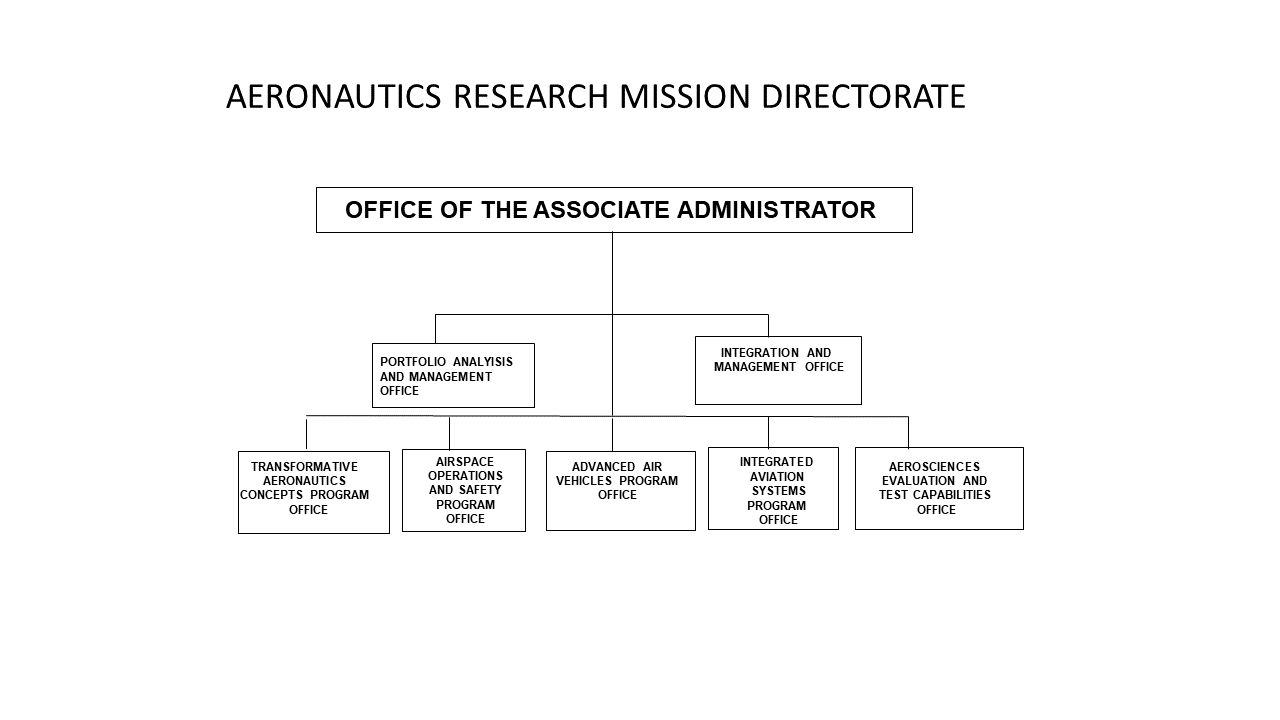
4.3.1 EMPHASIS: The Space Operations Mission Directorate (SOMD) is responsible for enabling human and robotic exploration of the solar system. SOMD manages NASA crewed space operations in low-Earth orbit (LEO), commercial launch services, and planning for future exploration missions when appropriate. SOMD develops and operates communications networks and space transportation systems and performs scientific research to enable sustained human exploration. In addition, SOMD is responsible for managing the space transportation services for NASA or NASA-sponsored payloads that require orbital launch, and the Agency's space communications and navigation services supporting all NASA space systems.
4.3.2 SOMD SPECIFIC RESPONSIBILITIES. Specifically, the SOMD Associate Administrator:
a. Implements responsibilities as stated in 4.1, Roles and Responsibilities Common to Mission Directorates.
b. Manages the formulation and development of human and related systems for Low Earth Orbit.
c. Manages launch services for the Agency in coordination with other Mission Directorates.
d. Manages the Agency space communications and navigation services, in coordination with other Mission Directorates.
e. Serves as the Agency spectrum manager in accordance with NPD 2570.5.
f. Manages infrastructure related to crew operations including crew training and medical support, rocket testing capabilities, and other infrastructure management.
g. Manages the Rocket Propulsion Test capability portfolio.
4.3.3 SPECIAL RELATIONSHIPS.
a. The Launch Services Flight Planning Board provides a forum for addressing NASA orbital space launch requirements, issues, and priorities for all NASA missions and NASA-sponsored payloads seeking launch on Commercial Launch Vehicles. The Board is chaired by the Director, Launch Services and is comprised of membership from SOMD, Science Mission Directorate (SMD), Space Technology Mission Directorate (STMD), the NASA Chief Engineer, and the Chief, Safety and Mission Assurance.
b. The Space Communications and Navigation (SCaN) Board of Directors is a forum to share information and seek advice for the Program Manager to better meet the Agency's space communications and navigation requirements. The Board is chaired by the AAs for SOMD and SMD and comprised of senior management from SCaN's key NASA customers and relevant technical offices (Office of the Chief Engineer, Office of the Chief Information Officer, and the Office of the Chief Technologist).
c. The ISS National Laboratory management organization is authorized in accordance with P.L. 111-267 Sec. 504(c)(2). The scope of work and relationship of the ISS National Laboratory management organization with NASA will be established through a Cooperative Agreement.
d. The Rocket Propulsion Test (RPT) Program provides the program management structure necessary for ensuring core capability for rocket propulsion testing and is NASA's authority for rocket propulsion assignments. The program is executed by the program manager who resides at SSC with support from MSFC, GRC/Plum Brook Station, and JSC/White Sands Test Facility. The National Rocket Propulsion Test (RPT) Alliance, formed by an agreement between NASA and the Department of Defense, works to shape the government's RPT capability to efficiently meet national test needs through intra and interagency cooperation.
4.3.4 IMMEDIATE LINE OF SUCCESSION.
In the following order: Deputy Associate Administrator (DAA) and DAA, Management SOMD.
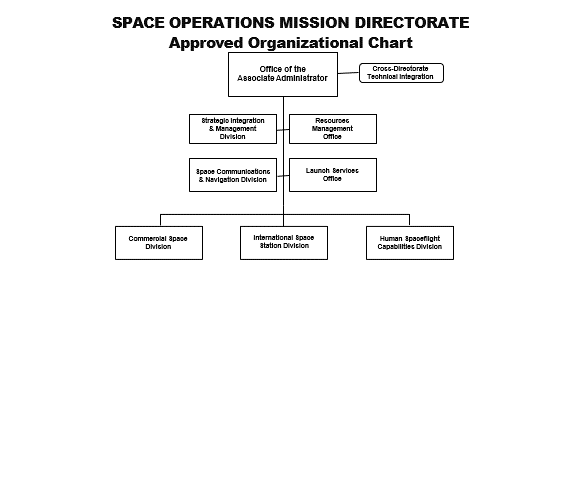
4.4.1 EMPHASIS: The Exploration Systems Development Mission Directorate (ESDMD) is responsible for planning, development and execution of the Artemis campaigns and for the Mars Campaign. ESDMD manages the human exploration system development and operations for deep space transportation, Lunar orbital, Lunar surface, and Mars exploration. ESDMD leads the human aspects of the Artemis activities as well as the integration of science into the human system elements. ESDMD is responsible for development of the Lunar and Mars architectures and participating on the Federated Board. The Mission Directorate implements the development and operations of Artemis elements through the Moon to Mars Program Office. Programs under the purview of the Moon to Mars Program Office include Orion, Space Launch System (SLS), Exploration Ground Systems (EGS), Gateway, Human Landing System (HLS), and xEVA and Human Surface Mobility (EHP). Additionally, the ESDMD leads the human aspects of the Artemis activities as well as the integration of science into the human system elements.
4.4.2 ESDMD SPECIFIC RESPONSIBILITIES.
a. Implements responsibilities as stated in 4.4.1, Roles and Responsibilities Common to Mission Directorates.
b. Manages the formulation, development, and operation of human and related systems for deep-space operations.
c. Manages the development of a Moon to Mars architecture.
d. Manages planning of all Artemis missions.
e. Develops required hardware for mission execution for the Artemis Missions.
f. Operates Artemis Missions.
g. Manages the development of exploration capabilities to be advanced for Moon and Mars missions.
h. Manages the conceptual design, mission planning and hardware development for Mars missions.
4.4.3 IMMEDIATE LINE OF SUCCESSION. In the following order: Deputy Associate Administrator (DAA); DAA, Moon to Mars Program.
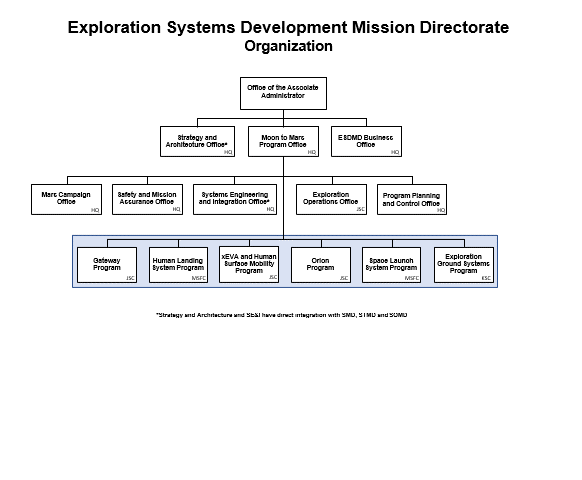
4.5.1 EMPHASIS. The Science Mission Directorate (SMD) carries out the scientific exploration of Earth and space to expand the frontiers of Earth Science, Heliophysics, Planetary Science, Astrophysics, and Biological and Physical Sciences. Through a robust fleet of orbiting and landed robotic spacecraft, a suborbital program of sounding rockets, scientific balloons, and research aircraft, as well as a broad and diverse grants-based research program, SMD provides virtual human access to the farthest reaches of our Solar System and beyond, as well as critical information about our home planet and sustained human exploration.
4.5.2 SMD SPECIFIC RESPONSIBILITIES.
Specifically, the SMD Associate Administrator:
a. Implements responsibilities as stated in 4.1, Roles and Responsibilities Common to Mission Directorates.
b. Oversees, in coordination with the Centers, the Mission Support Directorate, and the Technical Authorities, the formulation and development of robotic systems for suborbital, Earth orbital, and deep space operations.
c. Develops and/or leverages advanced technologies to meet science mission requirements and enable new scientific discoveries.
d. Extends the benefits of NASA science, technology, and information to the Nation through partnerships with other Federal agencies and other organizations relied upon by decision makers and citizens.
e. Ensures that data and information from NASA science missions are openly available and accessible in a timely and affordable manner.
f. Manages the conduct of life and physical science research and development of technologies targeted for human exploration and operations.
g. Assesses individual mission statements for the offices listed below that report to SMD:
(1) Mars Sample Return Program Office.
h. Manages establishment of the High End Computing capability portfolio.
4.5.3 SPECIAL RELATIONSHIPS.
a. Manages the development and launch of weather satellites for the National Oceanic and Atmospheric Administration (NOAA) on a reimbursable basis via the Agency's Joint Agency Satellite Division (JASD).
b. Provides leadership and supports sponsorship to specialized, science-related institutes, e.g., NASA Goddard Institute for Space Studies (GISS), NASA Astrobiology Institute (NAI), and the Space Telescope Science Institute (STScI).
4.5.4 IMMEDIATE LINE OF SUCCESSION.
In the following order: SMD Deputy Associate Administrator; SMD Deputy Associate Administrator for Programs; and SMD Deputy Associate Administrator for Management.
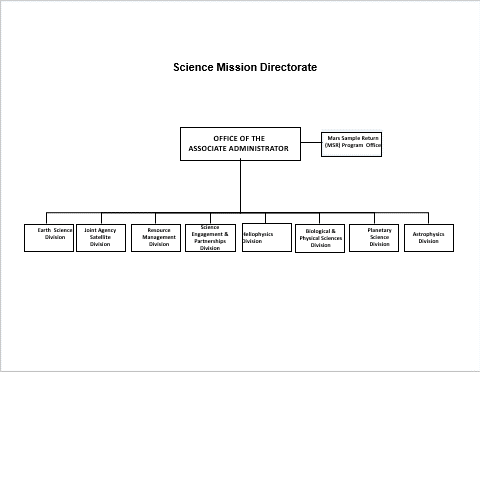
4.6.1 EMPHASIS: The Space Technology Mission Directorate (STMD) develops and demonstrates high-payoff technologies with the intent to infuse into current and future NASA missions. This organization employs a merit-based competition model with a portfolio approach spanning a range of discipline areas and technology readiness levels to advance technologies for the benefit of NASA, the aerospace industry, other Government agencies, as well as to address national needs.
4.6.2 STMD SPECIFIC RESPONSIBILITIES.
Specifically, the STMD Associate Administrator:
a. Implements responsibilities as stated in 4.1, Roles and Responsibilities Common to Mission Directorates.
b. Manages the STMD portfolio at the theme level, setting priorities and strategies for achieving technology, innovation, and infusion objectives.
c. Develops and coordinates crosscutting and pioneering technologies and capabilities to ensure the needs of the Agency and associated technology partners, in coordination with the Centers, the Mission Support Directorate, other Mission Directorates, and the Technical Authorities.
d. Leads technology transfer and commercialization while tracking performance across the Agency.
e. Provides management of the Agency's Small Business Innovation Research/Small Business Technology Transfer (SBIR/STTR) program.
f. Provides leadership, policy direction, and Agency-level strategy for prize competitions and Agency challenges, piloting new approaches and tracking the performance record.
4.6.3 SPECIAL RELATIONSHIPS. None.
4.6.4 IMMEDIATE LINE OF SUCCESSION.
In the following order: STMD Deputy Associate Administrator; STMD Deputy Associate Administrator for Management; and STMD Deputy Associate Administrator for Programs
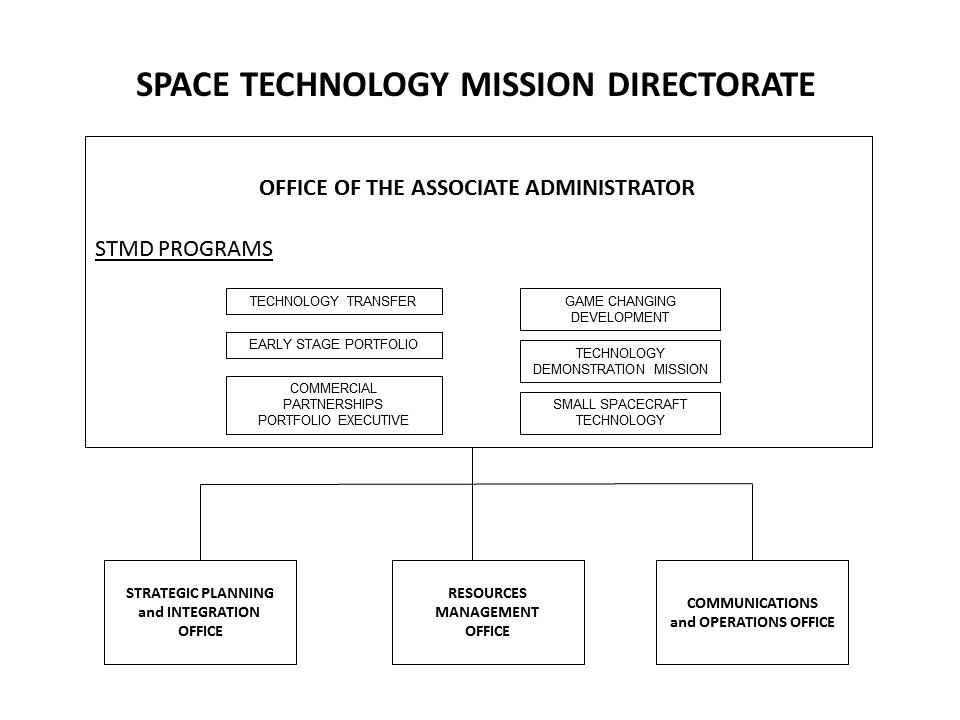
4.7.1 MISSION. The Mission Support Directorate (MSD) plans, integrates, and delivers all institutional support provided by mission support functions in an effective and efficient manner to enable the Agency to successfully accomplish its missions. It oversees and ensures mission support efficacy by focusing on reducing institutional risk to NASA's current and future missions through integration of cross-functional requirements, by improving processes, stimulating efficiency, and providing consistency and uniformity across all institutional capabilities, activities and services. It collaborates with other Mission Directorates and Centers to capture mission related institutional requirements and with the mission support functional area senior officials to consolidate and prioritize mission support. It collaborates with the Chief Engineer, Chief, Safety and Mission Assurance, and Chief Health and Medical Officer to manage the health and performance of their organizations.
4.7.2.1 OVERALL RESPONSIBILITIES. The Associate Administrator (AA) for Mission Support reports to the NASA Deputy Associate Administrator.
In planning and execution of Agency-wide mission support, the AA for Mission Support:
a. Establishes direction, develops and implements plans for mission support enterprise-wide goals, objectives, metrics and actions needed to execute the strategic goals and outcomes in the NASA Strategic Plan.
b. Integrates and aligns mission support activities (per 4.7.2.2, 4.8-4.9, 4.11-4.20) in support of agency strategic needs, and to provide consistent service. Interfaces with the Office of the Administrator and all organizations to provide integration.
c. Through the MSPMC, within the scope of its charter, and in coordination with other Boards established by the MSC, establishes mission support governance.
d. Identifies and manages mission support enterprise risk. Identifies, integrates and monitors the management of mission support risk. In coordination with the Office of the Chief Financial Officer, monitors and assures that effective internal controls are in place.
e. Monitors performance of all mission support functions against established baselines.
f. Manages the development of the Safety, Security and Mission Services (SSMS), Construction of Facilities (CoF) and Environmental Compliance and Restoration (CECR) budgets. Allocates resources in support of mission support functions. Establishes consistent practices for management and reporting of SSMS funds at Headquarters and Centers.
g. In consultation with Center Directors, provides input on the assignment, promotion, discipline and relief of the principal mission support interface at each Center (i.e., the Associate Center Director).
h. Serves as a liaison to external organizations performing similar functions and to stakeholders who establish Government-wide policies and requirements.
4.7.2.2 As an executing mission support line organization, the AA for Mission Support:
a. Oversees the Offices of the Chief Human Capital Officer, Office of Strategic Infrastructure, Office of Procurement, Office of Protective Services, Mission Support and HQ Operations Office, and NASA Shared Services Center. Approves these offices' individual mission statements, as well as Roles and Responsibilities Common within the Mission Support Directorate.
b. Individual mission statements for the offices listed below that report to MSD:
(1) Roles and Responsibilities Common within the Mission Support Directorate.
(2) Office of the Chief Human Capital Officer.
(3) Office of Strategic Infrastructure.
(4) NASA Shared Services Center.
(6) Office of Protective Services.
c. Ensures that MSD functional programs meet NASA's strategic needs. Monitors MSD functional programs' performance and issues corrective actions as needed.
d. Ensures statutory, regulatory and fiduciary compliance of MSD functions and programs. Ensures reporting as required by Congress, the Office of Management and Budget, and other external bodies for MSD functions and programs.
e. Manages establishment of the Agency's Aircraft Capability Portfolio for NASA aircraft services and activities. Manages the Agency's Space Environments Test Capability Portfolio. Charters governance bodies as needed to assist in management of these portfolios.
f. Serves as the decision authority for matters of partnership approval process/procedure and is the primary arbiter of interpretation and application of current partnership policy. Through the Partnership Office, provides policy guidance, operational support, advocacy and training for the Agency's domestic partnerships function and provides analytical decision support to the NASA Acquisition Strategy Council.
g. Manages the NASA Ombuds Program.
h. Ensures alignment of facilities, workforce and partnerships to Section 6.2, Center Roles.
4.7.2.3 In support of NASA HQ, the AA for Mission Support:
a. Provides the following institutional services and products to NASA Headquarters: facilities management and logistics services, safety and occupational health services, designated emergency management official, liaison for anti-harassment matters, ombudsman, NASA HQ Exchange, engagement and communication support for HQ-related activities.
b. Ensures the provision of NASA Headquarters mission support services including human capital, information technology, diversity and equal opportunity, communications, procurement, protective services and emergency management. Ensures integration across all mission support services delivered to Headquarters organizations.
4.7.3 SPECIAL RELATIONSHIPS.
4.7.3.1 The AA for Mission Support serves as a member of NASA's governance bodies as defined in Chapter 3 of this NPD.
4.7.4 IMMEDIATE LINE OF SUCCESSION. In the following order: Deputy AA for Mission Support; Deputy AA Integration, Strategy, and Transformation, Chief Human Capital Officer.
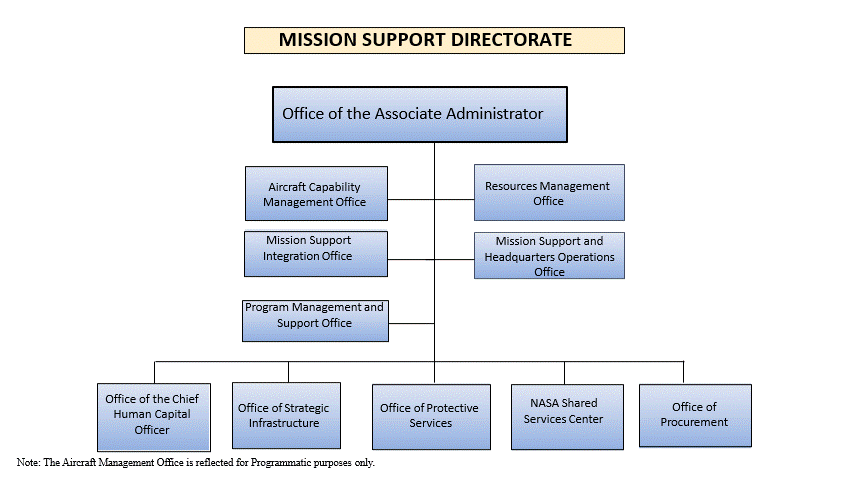
4.8.1 MISSION. As stewards of NASA's financial resources, the Office of the Chief Financial Officer provides expert financial and budgetary advice, analysis, operations, internal controls, strategic planning, and policies to ensure effective decision making, trustworthy advice and reliable outcomes.
4.8.2 OVERALL RESPONSIBILITIES. The Chief Financial Officer reports to the NASA Administrator.
4.8.2.1 Specifically, the Chief Financial Officer:
a. Oversees all financial management, budget, strategic planning, and performance activities relating to the programs and operations of the Agency.
b. Develops and implements plans that include the organization's goals, objectives, metrics, and actions needed to execute the strategic goals and outcomes in the NASA Strategic Plan.
c. Directs, manages, and provides policy guidance and oversight of the Agency's financial management personnel, activities, and operations.
d. Provides for the oversight and financial management of Agency resources and activities relating to programs and operations, ensuring strategic alignment with Agency mission and national goals, including all resources aspects of the planning, programming, and budgeting process.
e. Reviews, assesses, and validates Agency resources, requirements, and requests on the basis of strategic alignment, priorities, quality, and performance, including recommendations to the Administrator for fiscal resources approvals and authorizations.
f. Develops, maintains, and provides policy guidance and oversight of the Agency's integrated planning, budgeting, performance reporting, financial assistance, accounting, and financial management system, including financial reporting and financial management internal controls.
g. Monitors the financial execution of the Agency budget in relation to actual expenditures, monitors quality and performance of ongoing financial activities, analyzes ongoing activities to proactively identify potential performance problems, and prepares and submits timely financial and performance reports to the Administrator.
h. Ensures that budget formulation and execution are consistent with the Agency's strategic investment decisions and serve as the authoritative source for Agency programmatic and institutional strategic requirements.
i. Prepares and transmits an annual financial statement, audit report, and budget information to the Administrator, the Director of the Office of Management and Budget, the congressional committees of jurisdiction, and other authorities who review NASA's financial matters.
j. Works with the Comptroller General and administrative officials to facilitate financial management improvements consistent with the CFO Act, Office of Management and Budget guidance, and other relevant legislation.
k. Leads the Agency's effort in financial reporting under the CFO Act and coordinates on the Annual Performance Plan and Performance Report in accordance with the Government Performance and Results Act (GPRA) Modernization Act of 2010 (Public Law 111-352), as well as the Foundations For Evidence-Based Policymaking Act of 2018 (Public Law 115-435), and other relevant legislation.
l. Provides direct financial advice and support to Center leadership, Mission Directorate leadership, and other leaders across all NASA operational units.
m. Provides overall coordination, implementation and integration of NASA's risk-based Internal Control Program. Ensures that internal control policies and procedures are in place; documents and reports on key controls; evaluates the design of internal controls; tests and validates the operating effectiveness of internal controls; supports the correction of internal control deficiencies and recommends revisions to related policies and procedures to improve management performance. Manages and facilitates the preparation of the Administrator's annual Statement of Assurance.
n. Identifies the need for, develops, advocates, and manages, as appropriate, Internal Control Assessments and Quality Assurance Reviews designed to improve Agency management and reduce the risk of internal control deficiencies. Supports and tracks the correction of identified deficiencies through the Senior Assessment Team.
4.8.3 SPECIAL RELATIONSHIPS.
4.8.3.1 The Chief Financial Officer serves as a member of NASA's governance bodies as defined in Chapter 3 of this NPD.
4.8.3.2 As required by the CFO Act, the Chief Financial Officer is appointed by the President with the advice and consent of the Senate, and:
a. In coordination with the Office of Legislative and Intergovernmental Affairs, serves as interface with Congress on budget and financial matters.
b. Serves on the Office of Management and Budget's Chief Financial Officers Council.
c. Serves as NASA's Senior Accountable Official for Domestic Sourcing.
4.8.3.3 The Deputy Chief Financial Officer oversees the day-to-day operations of the OCFO Enterprise and Center OCFO Operations and long-term strategies of the offices by providing leadership for the planning, analysis, management, and operations of NASA's field Centers and NASA HQ operational resources functions. Provides continuity of leadership in the absence of the Chief Financial Officer.
4.8.3.4 The Deputy Chief Financial Officer for Appropriations serves as the Agency's appropriations liaison with the House and Senate Committees on Appropriations, providing leadership/direction/coordination of Agency communications with Committees on Appropriations.
4.8.3.5 The Deputy Chief Financial Officer for Strategic Insights and Budget serves as the Performance Improvement Officer and OCFO representative on the Agency Program Management Council. The DCFO for Strategic Insights and Budget also serves on the Office of Management and Budget's Performance Improvement Council.
4.8.3.6 The Associate Chief Financial Officer for Agency Budget serves as the principal administrative official for Agency funds and resources and directs, monitors, and approves the structure of budget formulation and execution and, in coordination with the Director, Financial Management Division, apportionments and allotments.
4.8.3.7 The Director, Quality Assurance Division, within the Office of the Chief Financial Officer, leads the Agency management assurance relative to the accountability and effectiveness of Federal programs and operations by establishing, assessing, correcting, and reporting on internal control. Makes recommendations to the Agency management to ensure programs operate and resources are used consistent with Agency missions, in compliance with laws and regulations, and with minimal potential for waste, fraud, and mismanagement.
4.8.3.8 The Director, Financial Management Division, within the Office of the Chief Financial Officer, oversees the Agency's compliance with financial regulations and reporting requirements. The Division oversees the implementation of the Agency's Continuous Monitoring Program for financial operations, ensuring funds are made available in a timely manner and monitoring funding alignment and balances, and that accounting practices are consistent with Federal accounting guidelines. The Division ensures adequate controls over NASA assets; compliance with the Federal Accounting Standards Advisory Board standards and principles; and implementation of environmental liability standards.
4.8.4 IMMEDIATE LINE OF SUCCESSION. In the following order: Deputy Chief Financial Officer and Deputy Chief Financial Officer for Strategic Insights and Budget. The process for designating an Acting Chief Financial Officer is set forth at 5 U.S.C. 3345 et. seq.
4.8.4.1 The Deputy Chief Financial Officer shall serve as Acting Chief Financial Officer immediately and automatically upon occurrence of the vacancy up to the appointment of a new Chief Financial Officer, Presidential action under the Vacancies Reform Act, 5 U.S.C. 3345, or the expiration of authority under the Vacancies Reform Act. If both the Offices of the Chief Financial Officer and Deputy Chief Financial Officer are vacant, the Deputy Chief Financial Officer for Strategic Insights and Budget shall perform the duties of the Chief Financial Officer immediately and automatically upon occurrence of the vacancies up to the appointment of a new Chief Financial Officer, Presidential action under the Vacancies Reform Act, 5 U.S.C. 3345, or the expiration of authority under the Vacancies Reform Act. If the Office of the Chief Financial Officer is vacant and authority for both the Deputy Chief Financial Officer and the Deputy Chief Financial Officer for Strategic Insights and Budget to serve under the Vacancies Reform Act has expired, no individual can perform the duties of the Chief Financial Officer without Presidential action unless otherwise authorized by law. However, in that event, all authorities of the Chief Financial Officer that may be legally delegated are delegated to the incumbent official in the following order of precedence: Deputy Chief Financial Officer, Deputy Chief Financial Officer for Strategic Insights and Budget, Deputy Chief Financial Officer for Finance, and Deputy Chief Financial Officer for Appropriations. In consultation with the General Counsel, such official exercising authority under this delegation shall also request Administrator action to request Presidential action for the appointment of an Acting Chief Financial Officer.
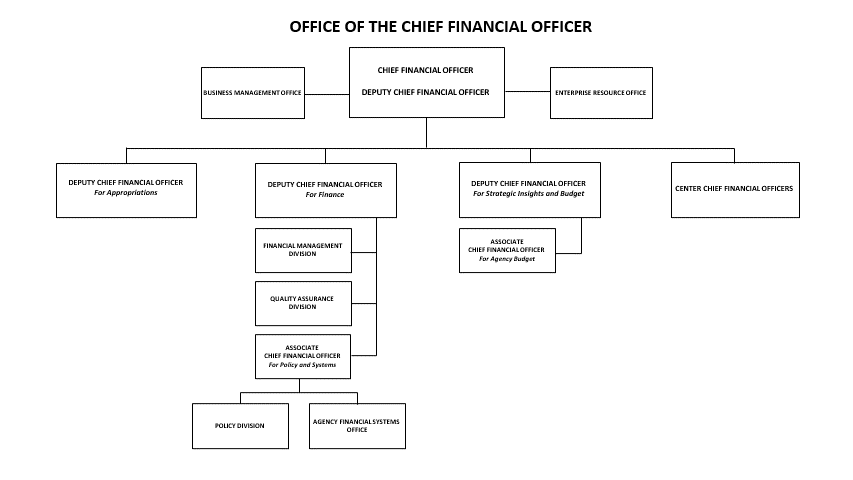
4.9.1 MISSION. The Office of the Chief Information Officer provides leadership, planning, policy direction, and oversight for the management of NASA information and NASA information technology (IT) in accordance with the responsibilities required by the Privacy Act of 1974, the Paperwork Reduction Act of 1995, the Clinger-Cohen Act of 1996, the E-Government Act of 2002, the Federal Information Security Management Act of 2002, and the Federal Information Technology Acquisition Reform Act of 2014. The Chief Information Officer (CIO) is the principal advisor to the Administrator and other senior officials on matters pertaining to IT, the NASA Enterprise Architecture (EA), cybersecurity, records management, and privacy.
4.9.2 OVERALL RESPONSIBILITIES. The CIO reports to the NASA Administrator.
4.9.2.1 Specifically, the CIO:
a. Develops and implements plans that include the organization's goals, objectives, metrics, and actions needed to execute the strategic goals and outcomes in the NASA Strategic Plan.
b. Manages the office functions by reducing enterprise risk to missions.
c. Directs, manages, and provides policy guidance and oversight of the Agency's Center CIOs' activities and operations, including, in partnership with Center Directors, the approval of the assignment, promotion, discipline, and relief of the principal CIO at each Center, and assessment of their performance. Conducts formal performance planning and appraisal of the principal CIO at each Center with feedback from the Center Director, who may provide a written evaluation that shall be attached to that individual's annual performance appraisal.
d. In consultation with the Center CIOs, determines the appropriate staffing complement for Center CIO offices.
e. Defines IT service objectives and top-level requirements and monitors service performance, as well as effectiveness and efficiency of IT services and processes.
f. Develops and implements Agency-wide strategies, policies, programs, and processes for the management of IT investments and services.
g. Provides for effective governance of IT through chartered boards with appropriate stakeholder representation.
h. Ensures statutory, regulatory, and fiduciary compliance in the acquisition and implementation of IT.
i. Develops, maintains, and facilitates implementation of the NASA EA, which is the framework for ensuring that IT investments enable the mission and are integrated, efficient, and secure.
j. Maximizes the value and assesses and manages the risks of the IT plans and investments for NASA. Utilizes an IT investment management process that is integrated with Agency processes for making budgetary and financial decisions for NASA IT.
k. Manages NASA's IT systems as a joint responsibility with the NASA Centers, Mission Directorates, and Headquarters Offices. The Centers, Mission Directorates, and Headquarters Offices have responsibility for the applications, while the CIO has overarching responsibility for ensuring alignment of those applications with the NASA EA and for all aspects of the IT infrastructure in which those applications reside.
l. Manages an application portfolio management program in conjunction with the Centers, Mission Directorates, and Headquarters Offices to ensure a robust, yet efficient, set of applications to enable the NASA mission.
m. Leads and implements NASA's Cybersecurity program, ensuring appropriate confidentiality, integrity, and availability of all NASA's information assets throughout the system life cycle. The Office of Protective Services is responsible for the security of classified information and technologies.
n. Ensures that the NASA workforce possesses the requisite knowledge and skills in IT and information resources management.
o. Provides oversight for all Agency E-Government initiatives.
p. Oversees IT-related reporting as required by Congress, the Office of Management and Budget (OMB), and other external bodies.
4.9.3 SPECIAL RELATIONSHIPS.
4.9.3.1 The CIO serves as a member of NASA's governance bodies defined in Chapter 3 of this NPD.
4.9.3.2 The CIO serves as a member of the Federal CIO Council coordinated by OMB.
4.9.3.3 The CIO works in cooperation with the Office of the Chief Financial Officer, the Office of Procurement, and the Mission Support Directorate to develop a full and accurate accounting of IT expenditures, related expenses, and results.
4.9.3.4 The CIO works in conjunction with the Office of Protective Services to provide for the protection of information systems.
4.9.4 IMMEDIATE LINE OF SUCCESSION. In the following order: Deputy CIO Deputy CIO for Strategy; Deputy CIO for Operations; and Senior Agency Information Security Officer.
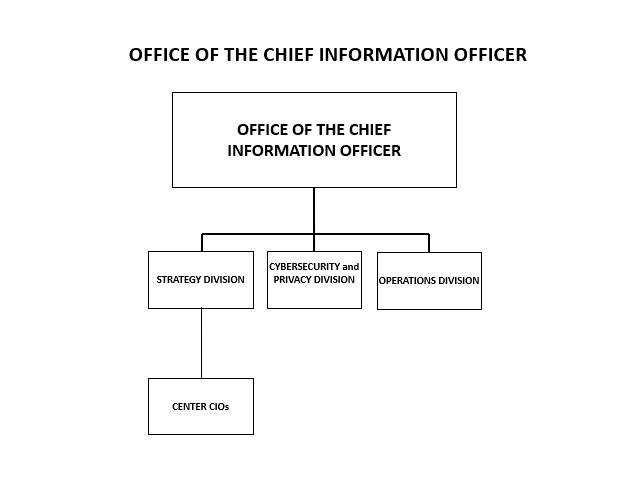
4.10.1 MISSION. The Office of the Chief Scientist (OCS) advises and advocates for the NASA Administrator on matters concerning Agency-wide science policy and programs. The OCS serves as a primary external interface regarding science issues and results on behalf of the Administrator. The OCS encourages and fosters science integration and cooperation across the Agency and provides oversight to assure that NASA funds only the most exemplary and meritorious science to enable NASA to achieve its mission.
4.10.2 OVERALL RESPONSIBILITIES. The Chief Scientist and Senior Climate Advisor reports to the NASA Deputy Administrator.
4.10.2.1 Specifically, the NASA Chief Scientist and Senior Climate Advisor:
a. Provides independent assessment and advice to the Administrator on matters related to NASA science.
b. Encourages and fosters science integration and cooperation across the Agency, including the Mission Directorates and the Centers.
c. Leads the development of Agency science strategy and ensures that NASA's overarching Strategic Plan properly incorporates science goals and objectives.
d. Performs scientific, technical, programmatic, and/or policy reviews to assure that NASA science programs are of the highest scientific and technologic merit and integrity.
e. Provides independent portfolio analysis of significant science activities, as appropriate.
f. Promotes, communicates, and advocates for NASA's science portfolio and strategy to the broad external community.
g. Represents NASA in promoting and maintaining good public and community relations and providing for the widest practical and appropriate dissemination of information concerning science and space activities.
h. Represents the Administrator to the National Advisory Council (NAC) Science Committee, the National Academy of Sciences, and other science advisory bodies.
i. Serves as the Administrator's NASA science representative to the international community, as appropriate.
j. Provides support and guidance to NASA science organizations in their development and implementation of plans to address science policy, goals, objectives, metrics, and actions needed to execute the strategic goals and objectives in the NASA Strategic Plan.
k. Works with the Center Directors to promote scientific vitality and innovation at the Centers.
l. Directs and oversees a Science Innovation Fund to promote the conduct of highly innovative, exploratory, and high-risk/high return scientific research at NASA Centers in support of the strategic direction of the NASA Centers and the Agency.
m. Directs and oversees the Agency nomination process for Agency-wide external and internal scientific awards.
4.10.3 SPECIAL RELATIONSHIPS:
4.10.3.1 Serves as a member of NASA's governance bodies as defined in Chapter 3 of this NPD.
4.10.3.2 Provides support and guidance to the Space Life and Physical Sciences Research and Applications Division in the Human Exploration and Operations (HEO) Mission Directorate to ensure its alignment with Agency science priorities and to increase the visibility of the HEO research portfolio at the Agency level.
4.10.4 IMMEDIATE LINE OF SUCCESSION. In the following order: Deputy Chief Scientist and Associate Chief Scientist.
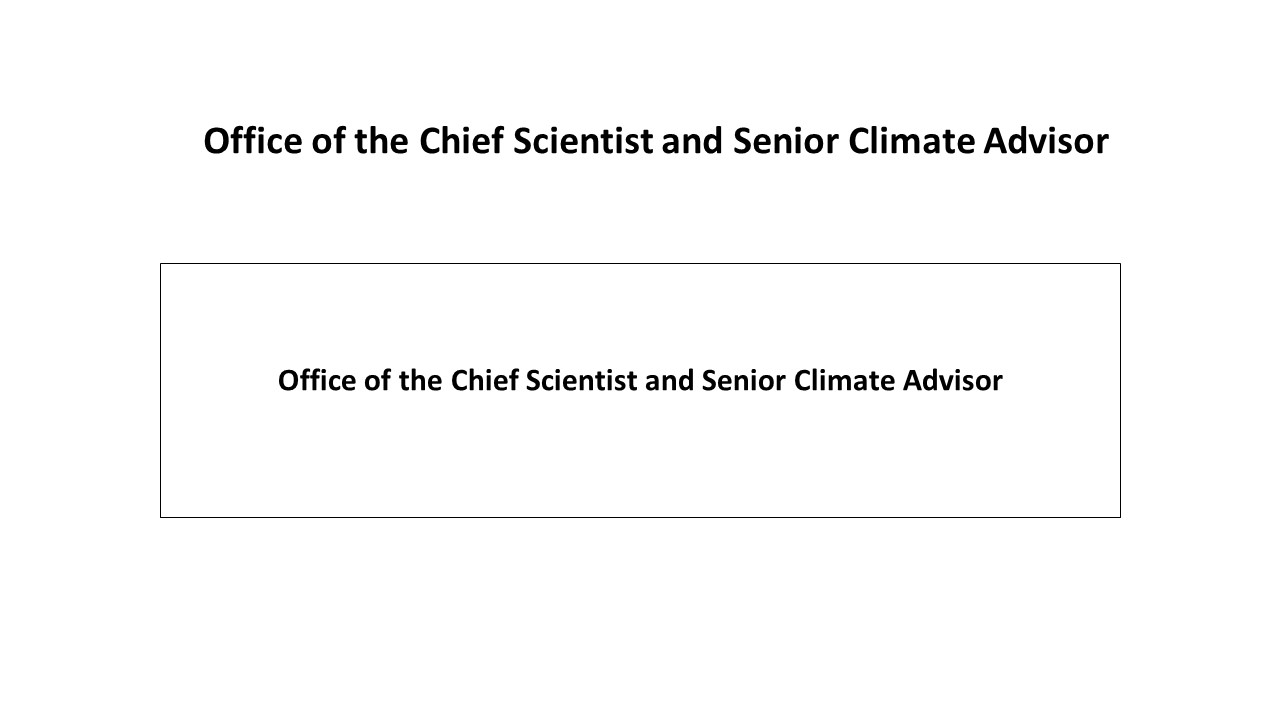
4.11.1 MISSION. The Office of the Chief Engineer provides policy direction, oversight, and assessment for NASA engineering and ensures the continuity and application of critical knowledge throughout NASA's engineering and program/project management workforce. It serves as the principal advisor to the Administrator and other senior officials on matters pertaining to technical readiness in execution of NASA programs and projects. Also, it is responsible for Agency-level standards and policies as applied to engineering and program management.
4.11.2 OVERALL RESPONSIBILITIES. The Chief Engineer reports to the NASA Associate Administrator.
4.11.2.1 Specifically, the Chief Engineer:
a. Develops and implements plans that include the organization's goals, objectives, metrics, and actions needed to execute the strategic goals and outcomes in the NASA Strategic Plan.
b. Manages the office functions by reducing risk to NASA's mission.
c. Serves as the lead Technical Authority for engineering.
d. Provides leadership, policy direction, functional oversight, assessment, and coordination for two major, closely related areas:
(1) Engineering and related technical disciplines, including systems engineering and technical integration.
(2) Program and project management, including earned value management and program integration.
e. Serves as the principal advisor to the Administrator on matters pertaining to the technical readiness of NASA programs and projects.
f. Assesses the adequacy, quality, and effectiveness of engineering work and program/project management Agency wide and recommends or directs improvements in these areas, where appropriate.
g. Coordinates the application of technical resources to support engineering work, including knowledge services and lessons learned, technical standards, trend evaluation, access to technical information, technical support for specific disciplines and problems, and coordination among engineering work groups.
h. Provides leadership to define the tools, processes, facilities, and engineering resources needed to improve the Agency's technical capabilities.
i. Oversees the NASA Engineering and Safety Center (NESC).
j. Establishes and maintains Agency-wide processes, technical standards, requirements, and policies for the conduct of discipline-area engineering and systems engineering. This shall include evaluating the implementation by the Centers and program/project management.
k. Establishes and maintains the Agency-wide process and requirements for engineering. This includes maintenance and update of NPR 7123.1, NASA Systems Engineering Processes and Requirements.
l. Provides leadership of and policy for the Agency's engineering and program/project management training conducted through NASA's Academy of Program, Project, and Engineering Leadership.
m. Implements and manages Agency-wide mandatory curriculum for program/project managers. This shall include providing and managing mandatory curriculum at NASA Centers. The Office of the Chief Engineer shall work with the Associate Administrator and the Chief Program Management Officer to ensure proper alignment of curriculum, with needed competencies for the future of NASA.
n. Coordinates with the Office of the Chief Human Capital Officer to ensure that new hiring policies and core competencies are in line with the future technical and program/project management needs for the Agency.
o. Conducts and integrates periodic and ad hoc programmatic and technical assessments of programs and projects.
p. Ensures statutory, regulatory, and fiduciary compliance.
q. Serves as a liaison to external organizations performing similar functions and stakeholders who establish Government-wide policies and requirements.
4.11.3 SPECIAL RELATIONSHIPS.
4.11.3.1 The Chief Engineer serves as alternate Chair for NASA's Program Management Council.
4.11.3.2 The Chief Engineer serves as a member of NASA's Mission Support Council (extended), Program Management Council, and Senior Management Council.
4.11.3.3 The Chief Engineer leads Engineers, Engineering Directors, and associated engineering organizations within Mission Directorates and Centers and, through them, within programs and projects.
4.11.3.4 The Chief Engineer chairs the Engineering Management Board for engineering infrastructure and practices.
4.11.4 IMMEDIATE LINE OF SUCCESSION. In the following order: Deputy Chief Engineer; Deputy for Management; and Director, NASA Engineering and Safety Center.
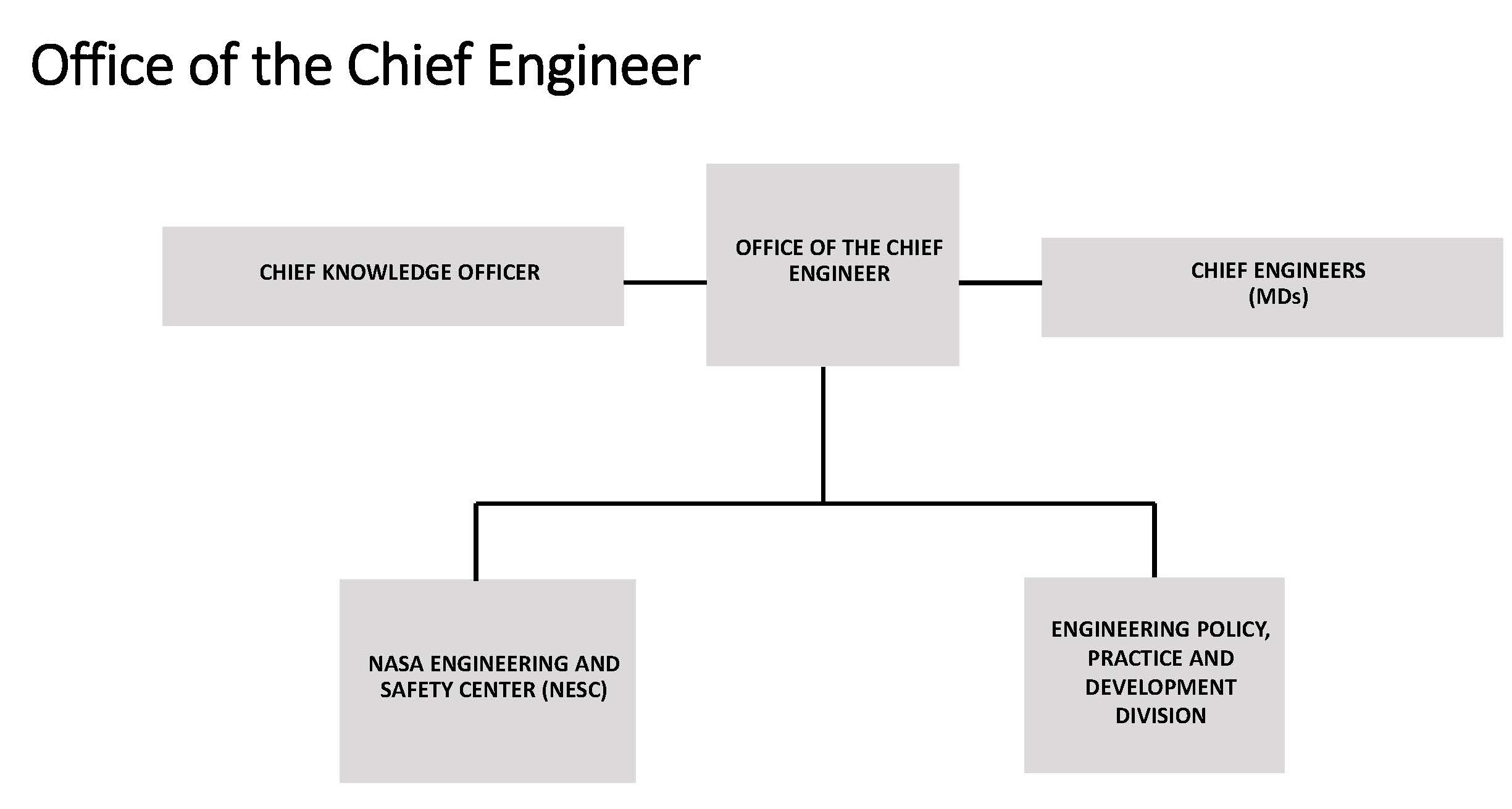
4.12.1 MISSION. The Office of the Chief Health and Medical Officer (OCHMO) serves as the focal point for policy formulation, oversight, coordination, and management of all NASA health and medical matters in all environments and medical emergency preparedness and contingency operations and response.
4.12.2 OVERALL RESPONSIBILITIES. The Chief Health and Medical Officer (CHMO) reports to the NASA Associate Administrator.
4.12.2.1 Specifically, the Chief Health and Medical Officer:
a. Provides review and oversight of health care delivery, assurance of professional competency, and quality and consistency of health care services Agency wide.
b. Formulates health care and medical policies for, and provides oversight of, activities related to crew health and medical operations for exploration in and beyond low-Earth orbit.
c. Establishes and maintains medical and human health-related standards and appropriate levels of medical care for all NASA activities and develops and implements processes for approving these standards.
d. Serves as the Agency Technical Authority for all health and medical requirements and matters.
e. Works with Mission Directorate Associate Administrators to review all human health-related program plans and requirements for compliance with established medical and health-related standards and practices.
f. Reviews and approves medical requirements and research products as ready for operational implementation through the established Transition to Medical Practice process.
g. Ensures Agency compliance with all statutory and regulatory requirements regarding the safe and ethical execution of research involving human and animal subjects.
h. Ensures Agency compliance with all statutory and regulatory requirements regarding the safe and ethical execution of medical practice.
i. Supports the Mission Directorates, as appropriate, regarding selection of research and development projects relative to research subjects, human health, and medical matters.
j. Supports the Space Operations Mission Directorate and Exploration Systems Development Mission Directorate in all activities pertinent to human space flight mission execution.
k. Manages the office functions by reducing institutional risks to missions.
l. Ensures coordination with the Office of International and Interagency Relations when health and medical and research subject matters have implications for international partners or NASA's international activities.
m. Coordinates NASA health and medical issues, policies, and programs with other NASA organizations, other Government agencies, industry, international participants, and academia.
n. Ensures that all employees are provided healthful workplaces free from exposures to harmful substances or conditions.
o. Serves as the Designated Agency Safety and Health Officer (DASHO) liaison to the Department of Labor.
p. Serves as the To Research, Evaluate, Assess, and Treat (TREAT) Astronaut's Act authority to determine which medical and psychological claims and conditions are associated with or potentially associated with spaceflight.
q. Provides medical monitoring and diagnosis for conditions considered potentially associated with spaceflight and treatment for conditions determined to be spaceflight-associated to former U.S. Government astronauts and payload specialists.
4.12.3 SPECIAL RELATIONSHIPS.
4.12.3.1 The CHMO serves as a member of NASA's governance bodies as defined in Chapter 3 of this NPD.
4.12.3.2 The CHMO is the principal advisor to both the Administrator and the Deputy Administrator on health and medical requirements, matters of astronaut health, research subject protection, and matters to ensure the mental and physical health and well-being of the NASA workforce in all environments.
4.12.3.3 The CHMO serves as the NASA liaison to the Occupational Safety and Health Administration, along with representatives from the Office of Safety and Mission Assurance.
4.12.3.4 The OCHMO serves as the primary NASA liaison to the Department of Health and Human Services, the Department of Defense, the Department of Homeland Security, the Department of Transportation, and other Federal departments concerning health and medical matters and research subject protection as appropriate.
4.12.3.5 The OCHMO maintains a standing committee of the Institute of Medicine to advise NASA on Aerospace Medicine and Medicine of Extreme Environments.
4.12.4 IMMEDIATE LINE OF SUCCESSION. In the following order: Deputy Chief Health and Medical Officer.
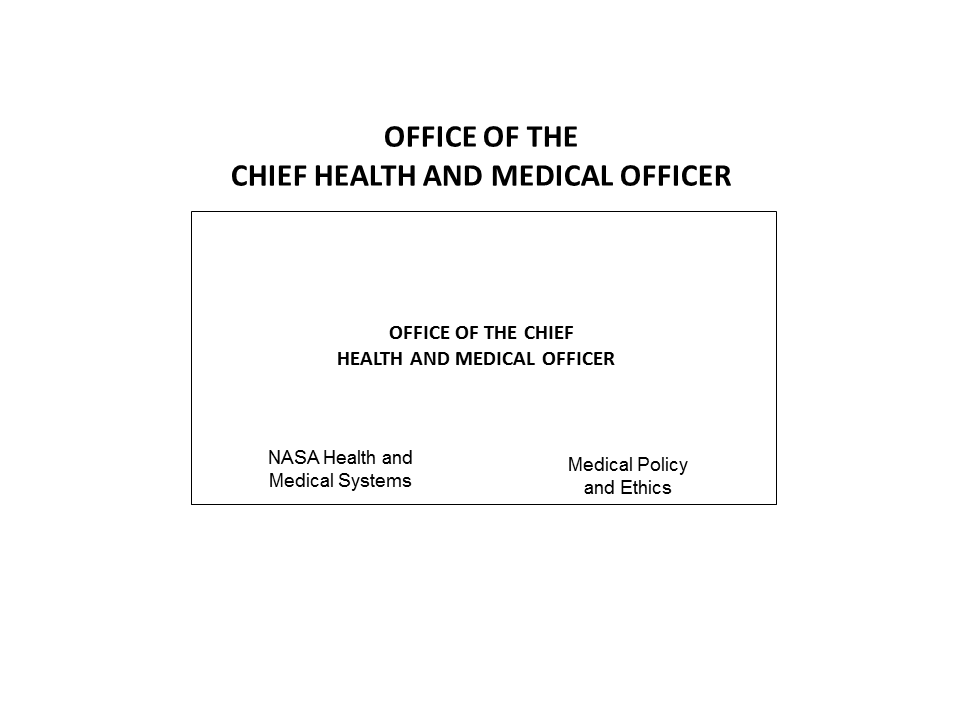
4.13.1 MISSION. The Office of Safety and Mission Assurance (SMA) provides policy direction, functional oversight, and assessment for all Agency safety, reliability, maintainability, quality engineering and assurance, software assurance, risk management, orbital debris mitigation, nuclear flight safety, aviation safety, and planetary protection activities and serves as a principal advisory resource for the Administrator and other senior officials on matters pertaining to safety and mission success.
4.13.2 OVERALL RESPONSIBILITIES. The Chief, Safety and Mission Assurance reports to the NASA Associate Administrator and advises senior leadership, including the Administrator, on matters related to risk, safety, and mission success. Serves as the lead Technical Authority for safety and mission assurance, providing independent oversight of programs and projects in support of safety and mission success. Serves as the designated Agency-level "official voice" for institutional safety and the associated requirements established by NASA policy, law, and other external mandate aimed at protecting the public, NASA workforce, and high-value assets from potential harm as a result of activities and operations created or controlled by NASA and to protect NASA civil servants from hazards, regardless of location.
4.13.2.1 Specifically, the Chief, Safety and Mission Assurance:
a. Develops and implements plans that include the organization's goals, objectives, metrics, and actions needed to execute the strategic goals and outcomes in the NASA Strategic Plan.
b. Develops SMA strategies, policies, requirements, procedures, standards, and guidelines for NASA programs, projects, and institutions (hereinafter abbreviated as SMA policy direction).
c. Ensures the incorporation and fulfillment of SMA policy direction through the structured implementation of SMA technical authority, institutional safety authority, and independent reviews and assessments.
d. Assesses and advances the effectiveness of SMA policy direction, activities, processes, and safety culture to address institutional and programmatic risk to safety and mission success.
e. Advises NASA leadership on significant SMA issues, including guidance for corrective action.
f. Assesses the need for and advances SMA tools, knowledge, techniques, and practices and workforce capabilities.
g. Assures that adequate levels of both programmatic and institutional resources are applied to SMA functions.
h. Oversees the prompt investigation and development of findings and recommendations for safety concerns and NASA mishaps and ensures appropriate closure of corrective actions.
i. Concurs with the assignment, promotion, performance appraisal, discipline, and relief of the principal SMA official at each Center.
j. Provides to each Center Director a written evaluation of the performance of the principal Center SMA official, which will be attached to that individual's annual performance appraisal.
k. Advocates and represents the NASA SMA programs and community to other U.S. Government organizations, industry, academia, and international participants.
4.13.2.2 The Chief, Safety and Mission Assurance is authorized to suspend any operation or project activity that presents an unacceptable risk to the public, workforce, property, environment, or mission success and provide guidance for corrective action.
4.13.3 SPECIAL RELATIONSHIPS.
4.13.3.1 The Chief, Safety and Mission Assurance serves as a member of NASA's governance bodies as defined in Chapter 3 of this NPD.
4.13.3.2 The Chief, Safety and Mission Assurance establishes program direction and budget, as well as supervises the performance of the NASA Safety Center.
4.13.3.3 The Chief, Safety and Mission Assurance, based on guidance from the IV&V Advisory Board, establishes program direction for, and supervises the performance of, the NASA IV&V Program.
4.13.3.4 The Chief, Safety and Mission Assurance, in coordination with the Chief Engineer, provides safety direction for the NASA Engineering and Safety Center.
4.13.3.5 The Chief, Safety and Mission Assurance supports the Chief Health and Medical Officer, who is the Designated Agency Safety and Health Official, by establishing and overseeing implementation of the safety portion of NASA's safety and health management policy required by 29 CFR � 1960.1.
4.13.4 IMMEDIATE LINE OF SUCCESSION. In the following order: Deputy Chief, Safety and Mission Assurance; Director, Mission Assurance and Capabilities Division; Director, Missions and Programs Assessment Division
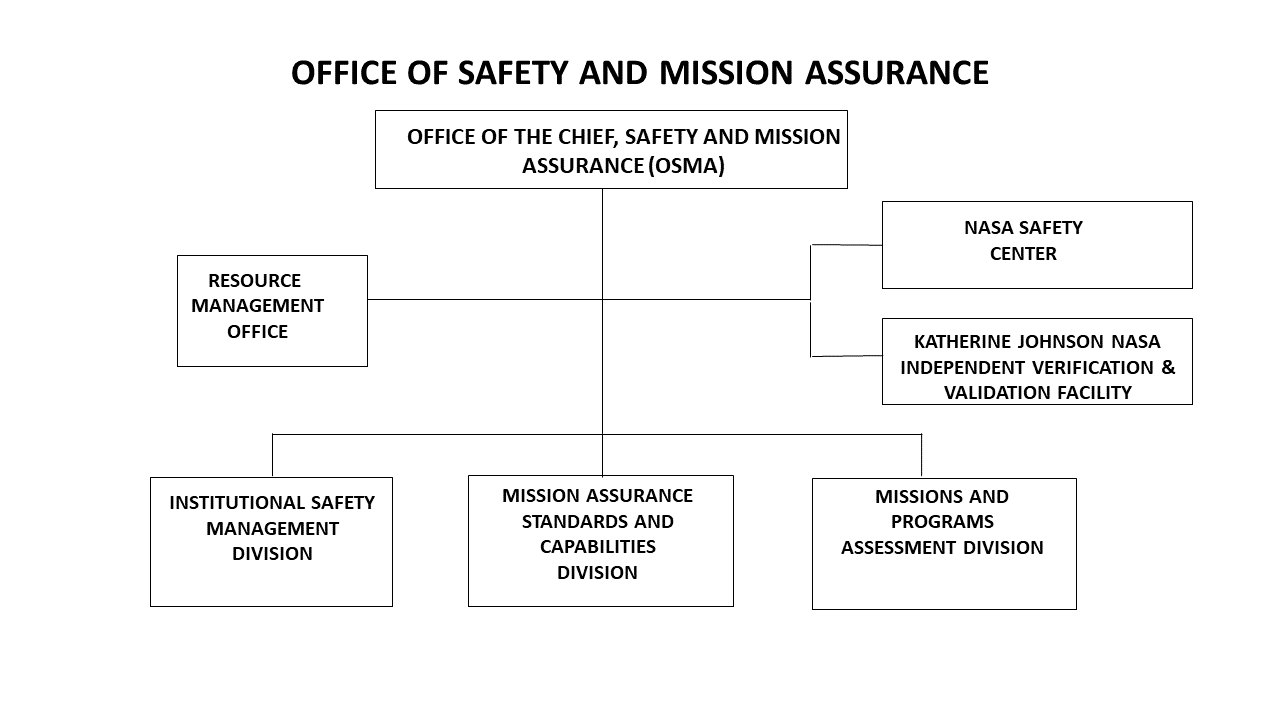
4.14.1 MISSION. The Office of Communications serves as NASA's authority and responsible office for developing and executing an Agency-wide communications plan that provides for the widest practicable and appropriate dissemination of information concerning the Agency's activities and results thereof, consistent with the Space Act. To that end, the office is responsible for developing a strategic communications plan that recognizes a diverse range of audiences and stakeholders (both internal and external), embraces an evolving set of communication tools and methods, and analyzes its efforts to ensure that the methods are being effective, and the Agency is demonstrating good stewardship.
Under its authority, the office is responsible for planning, organizing, directing, and coordinating Agency-wide communications activities for all facets of NASA's mission, programs, activities, and functions. The scope of Agency communications entails a broad, diverse, and integrated set of efforts including news and media engagement, digital services, and products (including web, multimedia, and social media), engagement activities, development of communications collateral and non-technical publications, exhibits development, as well as other ancillary activities to share the results of NASA's efforts. It manages the NASA brand, engages in strategic alliances and partnerships to support communications, and ensures books written about NASA and movies referencing NASA are factual. The office is also responsible for Agency library services, the history function, including maintaining archival records, and FOIA.
4.14.2 OVERALL RESPONSIBILITIES. The Associate Administrator (AA) for Communications reports to the NASA Administrator.
4.14.2.1 Specifically, the AA for Communications:
a. Develops and implements plans that address the organization's goals, objectives, metrics, and actions needed to execute the strategic goals and outcomes in the NASA Strategic Plan.
b. Develops and implements a strategic communications approach and operational model for guiding and executing all Agency communications activities including:
(1) Designs and implements internal and external communications strategies and tactics that support NASA's mission.
(2) Advises the Administrator, Deputy Administrator, Associate Administrator, and Chief of Staff on long-range and day-to-day activities involving Agency policy and communications activities.
(3) Provides Agency-wide standards and policies for communications activities and products, and is accountable for Agency-wide planning, development, and implementation of all NASA communications activities and products, including those required to communicate the work of the NASA Mission Directorates, Centers, and Headquarters functional organizations.
(4) Develops Agency-wide internal and external communications policies and instruments, including NASA's presence in the media, web, social media, and other platforms.
(5) Builds and maintains the NASA brand.
(6) Develops and implements, in coordination with the Office of the Administrator, communications activities and products for matters of policy, budgets, and missions.
c. Monitors Agency-wide communications performance and metrics, as well as effectiveness and efficiency of programs and processes.
d. Researches and develops effective, data-driven strategic messages that can be employed Agency-wide and targeted to specific audiences (internal and external) to increase public awareness and understanding of NASA and its missions.
e. Ensures the quality of communications activities and achieves consistency of approach, where appropriate, across the Agency through the integration and coordination of strategic communications functions and business processes.
f. Leads an Agency-wide program to establish and maintain open and credible communications channels within the entire NASA Communication and to external institutions and outlets, including the news media, web, and social media platforms, to reach and engage the general public. Coordinates with all NASA programs and Centers. Develops associated products and content, includes videos, applications, and other multimedia products.
g. Develops and adopts emerging technologies required for the dissemination of information to foster communications and facilitate public engagement.
h. Drafts speeches, op-eds, and articles for senior NASA officials and provides messaging support to other senior U.S. Government officials communicating about NASA's activities.
i. Identifies and coordinates NASA's participation in events, conferences, and public engagement activities, reaching new audiences and educating a broader segment of the American people on NASA and its mission. In conjunction with event planning and execution, manages the Agency-wide guest operations function for a variety of public engagement events.
j. Manages the Agency-wide exhibits and artifacts programs. Develops and deploys exhibits and related products for events, conferences, and public engagement activities.
k. Identifies and manages, as appropriate, opportunities for strategic partnerships with industry and media aimed at increasing public awareness of NASA's mission, leveraging existing resources to broaden NASA's presence with more diverse audiences, and ensuring efficient and appropriate use of NASA's communications materials.
l. Manages and operates the Agency's Speaker's Bureau, speaking engagements, and astronaut appearances. Coordinates public appearances by NASA officials.
m. Manages the NASA History and Archival program.
n. Manages the NASA Library Services program.
o. Manages Agency Art Program.
p. In consultation with Center Directors, approves the assignment, promotion, discipline, and relief of the principal Communications official at each Center and assesses their performance. Provides a written evaluation of the principal Communications official at each Center, which shall be attached to that individual's annual performance appraisal.
4.14.3 SPECIAL RELATIONSHIPS.
4.14.3.1 The AA for Communications serves as a member of NASA's governance bodies as defined in Chapter 3 of this NPD.
4.14.3.2 The AA for Communications assigns communications specialists to selected organizations to serve as dedicated Communications Officers. These Communications Officers will work with the assigned AAs and their staffs, providing professional communications expertise and support. The AA for Communications shall also manage direct reports at NASA Centers, who are the most senior communications leaders within their organizations. These communications leaders will work with their Center Directors and management, fostering Agency coordination and providing communications expertise and support. The AA for Communications shall also manage the Communications Coordinating Council, accountable for strategic direction and guidance of all NASA communications activities.
LINE OF SUCCESSION. In the following order: Deputy AA; Director of History and Information Services; Director of News, Media, and Internal Communications.
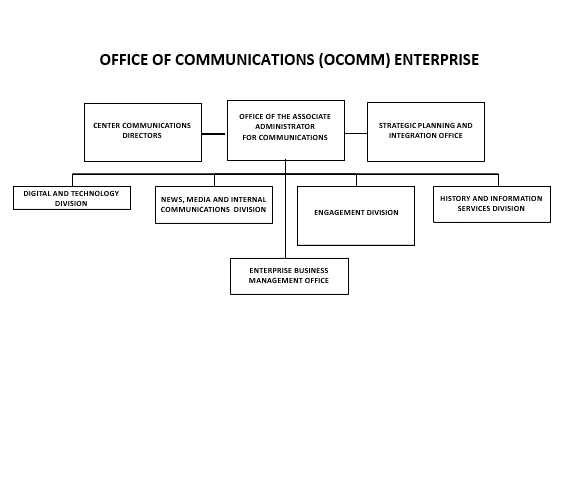
4.15.1 MISSION. The Office of Diversity and Equal Opportunity (ODEO) is responsible for developing, overseeing, and aligning NASA's civil rights programs, strategies, policies, and processes consistent with the Agency's mission, strategic goals, performance outcomes, and applicable federal regulations. ODEO establishes Agency-wide policies on civil rights to include diversity, inclusion and accessibility, equal employment opportunity (EEO), and equal opportunity (EO). The Office defines strategies, program objectives, and top-level requirements; ensures statutory, regulatory, and fiduciary compliance with internal and external equal opportunity laws; provides technical assistance, training, and advocacy to promote a diverse, inclusive and accessible workplace; ensures consistency of approach to improve functional performance across the Agency; and monitors civil rights program performance.
4.15.2 OVERALL RESPONSIBILITIES. The Associate Administrator (AA) for Diversity and Equal Opportunity reports to the NASA Administrator on all matters pertaining to civil rights policies and programs under Federal law and NASA rules and policy pursuant to executive orders, laws, rules, and regulations. The AA serves as the Agency's EEO Director and Chief Diversity Officer.
4.15.2.1 Specifically, the AA for Diversity and Equal Opportunity:
a. Serves as the principal advisor to Principals of the Office of the Administrator, all Officials in Charge, and Center Directors on civil rights including equal employment, diversity, and equal opportunity for NASA.
b. Develops and implements plans for ODEO that address the organization's goals, objectives, metrics, and actions needed to execute the strategic goals and outcomes in the NASA Strategic Plan.
c. Manages the office functions to reduce institutional risk to missions.
d. Is designated as the Agency's Director of Equal Employment Opportunity to perform the functions and responsibilities of that position under 29 CFR pt. 1614.
e. Oversees, establishes, and administers policy and procedural requirements of the Agency's Equal Opportunity complaint processes, compliance reviews, enforcement action(s), and harassment reporting pursuant to NASA Procedural requirement (NPR) 2081.1B, 14 CFR Part 1250-1253.
f. Develops the Agency's anti-harassment policy, strategy, and program. Guides the Agency's management strategies, objectives and actions required to maintain an agency-wide anti-harassment program in compliance with federal laws and regulations. Implementation of the Agency's anti-harassment program resides at the center level.
g. Administers effective and efficient Agency-wide Alternative Dispute Resolution (ADR) program.
h. Develops policies and procedures and manages the Agency's reasonable accommodation program. Guides the Agency's management strategies, objectives and actions required to maintain an agency-wide reasonable accommodation program in compliance with federal laws and regulations.
i. Develops and oversees Agency-wide policies, programs, and processes to achieve consistency of approach to eliminate barriers to employment to include recruitment, retention, and promotion of a high-caliber and diverse workforce, particularly in mission-critical occupations and leadership ranks.
j. In consultation with Center Directors, selects and approves the assignment, reassignment, promotion, discipline and relief of the principal Diversity and Equal Opportunity official at each Center.
k. In consultation with Center Directors, determines the appropriate staffing complement for Center Diversity and Equal Opportunity offices.
l. Defines diversity objectives and top-level requirements. Establishes and manages long-term Agency diversity planning and implementation.
m. Manages NASA's external compliance activities for conducted and assisted programs under applicable laws, rules and regulations. Oversees and maintains NASA's process.
n. Provides technical assistance for areas of general responsibility identified in this NPD for addressing unlawful discrimination of NASA's conducted and assisted programs and activities.
o. Develops and implements civil rights mandatory training requirements, develops, and delivers subject matter content and liaisons with NASA's training and development functional areas to include applicable civil rights competencies.
p. Leads diversity, accessibility and inclusion efforts across the Agency and establishes appropriate governance structures to integrate activities.
q. Provides leadership to Centers' Office of Diversity and Equal Opportunity Directors.
r. Provides liaison to external organizations performing similar functions and to stakeholders who establish Government-wide policies and requirements. This includes the Equal Employment Opportunity Commission, Department of Justice, Office of Personnel Management, etc.
s. With respect to the areas of general responsibility identified in this NPD, oversees reporting as required by Congress, the Office of Management and Budget, the Equal Employment Opportunity Commission, Department of Health and Human Services, and other external bodies.
4.15.3 SPECIAL RELATIONSHIPS.
4.15.3.1 The AA for Diversity and Equal Opportunity serves as a member of NASA's governance bodies as defined in Chapter 3 of this NPD.
4.15.3.2 The AA for Diversity and Equal Opportunity maintains special relationships with the Mission Support Directorate (regarding institutional integration of EO and diversity); the Office of Chief Human Capital Officer (e.g., recruitment, retention, professional development, mandatory training, succession planning), the Office of General Counsel (EO and civil rights legal requirements and complaint processing), the Office of STEM Engagement (diversity and EO in NASA-assisted and NASA-conducted educational programs), the Office of Procurement (NASA grants to private sector institutions), the Office of Legislative and Intergovernmental Affairs (Congressional matters pertaining to diversity and EO), the Office of Communications (diversity/EO communications); and the Office of Small Business Programs ("supplier" diversity).
4.15.4 IMMEDIATE LINE OF SUCCESSION. When necessary, succession decisions will be made by the Office of the Administrator.
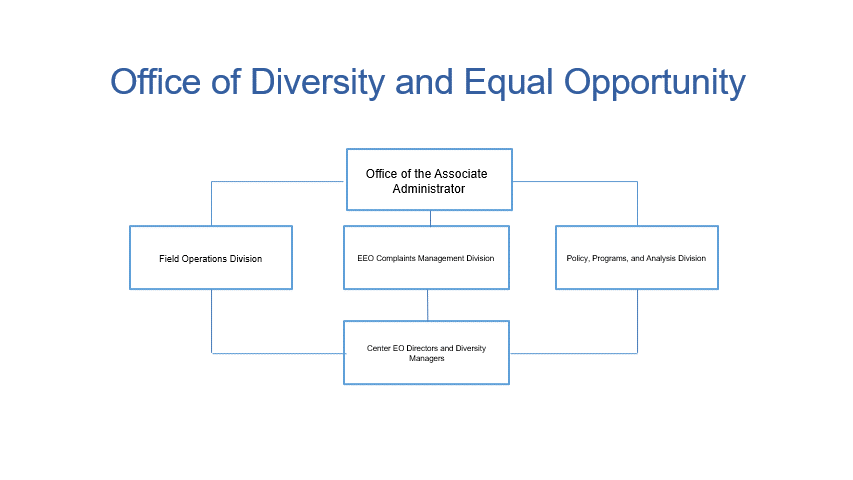
4.16.1 MISSION. The Office of Science, Technology, Engineering, and Mathematics (STEM) Engagement provides policy direction and leads strategy, planning, operational integration, and oversight, as well as assessment of the Agency's comprehensive set of functions, programs, projects, activities, and products dedicated to serve students, educators, and educational institutions. The scope of the Agency's STEM engagement function entails a broad set of efforts that enable unique opportunities for students to contribute to NASA's work and mission and engage students in learning experiences toward developing a diverse future STEM workforce. The Associate Administrator (AA) for STEM Engagement is the principal advisor to the Administrator and other senior officials on matters pertaining to STEM engagement and educational endeavors aimed to ultimately benefit students and educational institutions.
4.16.2 OVERALL RESPONSIBILITIES. The AA for STEM Engagement reports to the NASA Administrator.
4.16.2.1 Specifically, the AA for STEM Engagement:
a. Develops and implements plans that address the organization's goals, objectives, metrics, and actions needed to execute the strategic goals and outcomes in the NASA Strategic Plan.
b. Provides policy direction and leads the strategy, planning, operational integration, and assessment of the Agency's STEM engagement programs, projects, activities, and products.
c. Leads an effective Agency governance model with processes to ensure that the STEM engagement strategy, investments, implementation, and operational decisions are integrated with organizational planning, budget, financial management, human capital management, and programmatic decisions and processes.
d. Manages the comprehensive set of appropriated STEM engagement and education programs, projects, activities, and products, fully integrated across NASA Headquarters organizations and Centers, including component facilities and contractors in consonance with the contract terms.
e. Maintains an integrated Agency STEM engagement portfolio, including contributions from NASA Headquarters Offices, Mission Directorates, and Centers, to effectively engage and serve intended beneficiaries and audiences.
f. Guides strategic direction for the Agency's STEM engagement function toward achieving successful execution of measurable strategic objectives, focus area strategies, associated implementation plan, and related policies.
g. Ensures statutory, regulatory, and fiduciary compliance in the implementation of STEM engagement programs, projects, activities, and products.
h. Leads the process for development and execution of appropriated STEM engagement budget requirements, including managing budget approval and corporate resource implementation and monitoring financial performance.
i. Establishes and uses qualitative and quantitative metrics and assessment approaches and techniques to measure and evaluate the effectiveness of NASA STEM engagement activities. Maintains appropriate systems to track and report performance for STEM engagement activities, thereby enabling the appropriate monitoring of progress toward the Agency's strategic objectives.
j. Oversees STEM engagement reporting as required by Congress, the Office of Management and Budget, and other external bodies.
k. Ensures appropriate competency of the NASA STEM engagement workforce through training, mentoring, and professional development. Ensures that required skills are identified, developed, recruited, retained, and available to support Agency activities.
l. Engages and communicates with external stakeholders, and represents the Agency externally regarding matters in STEM engagement, in coordination with other NASA organizations, especially in interacting with Congress, the Office of Management and Budget, and other Federal agencies.
m. Serves as the liaison to external Federal institutions and other external organizations performing similar functions and entities that establish Federal Government-wide policies and requirements.
n. In consultation with Center Directors, approves the assignment, promotion, discipline, and relief of the principal STEM Engagement official at each Center and assesses their performance. Provides a written evaluation of the principal Center STEM Engagement official at each Center, which shall be attached to that individual's annual performance appraisal.
o. In consultation with Center Directors, determines the appropriate staffing complement for Center STEM Engagement offices.
4.16.3 SPECIAL RELATIONSHIPS.
4.16.3.1 The AA for STEM Engagement serves as a member of NASA's governance bodies as defined in Chapter 3 of this NPD.
4.16.3.2 The AA for STEM Engagement chairs the STEM Engagement Council.
4.16.4 IMMEDIATE LINE OF SUCCESSION. In the following order: Deputy Associate Administrator for Strategy and Integration; and Deputy Associate Administrator for Programs.
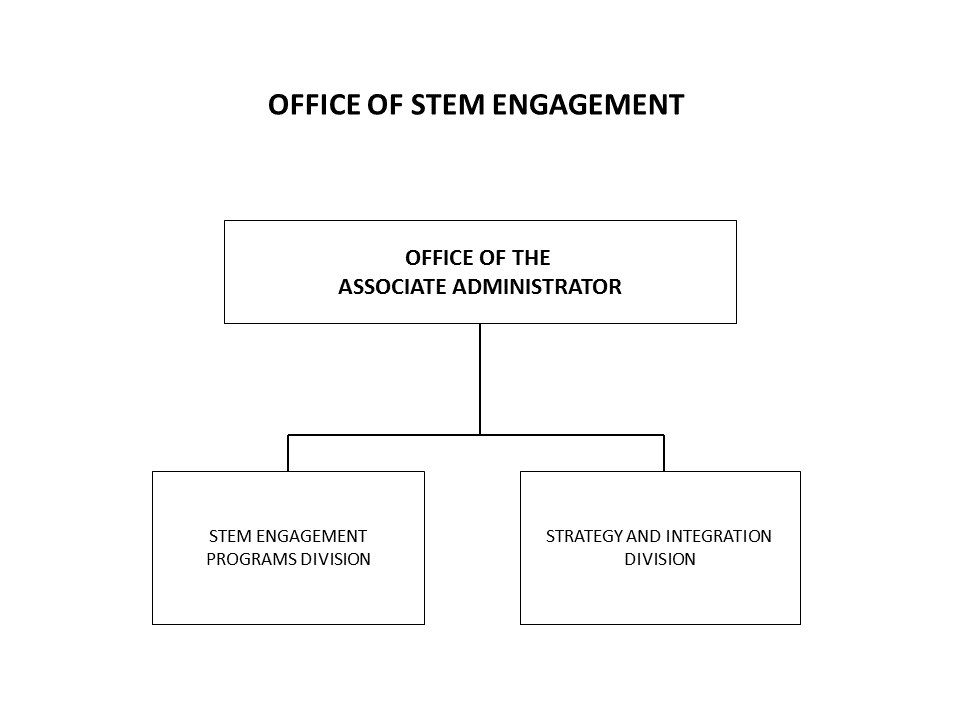
4.17.1 MISSION. The General Counsel establishes Agency-wide legal policy, provides legal advice, assistance, and Agency-wide functional guidance, ensures the appropriateness of all legal actions and activities Agency wide, and provides binding formal legal opinions on Agency matters. With respect to legal matters and issues, the General Counsel further ensures consistency of approach and eliminates duplication of functional support activities through collaboration, centralization, and/or consolidation of functions between and within Headquarters, the Centers, and separate NASA entities.
4.17.2 OVERALL RESPONSIBILITIES. The General Counsel reports to the NASA Administrator.
4.17.2.1. Specifically, the General Counsel:
a. Develops and implements plans that address the organization's goals, objectives, metrics, and actions needed to execute the strategic goals and outcomes in the NASA Strategic Plan.
b. Manages the office functions by reducing institutional risk to missions.
c. Selects, assigns, supervises, promotes, evaluates, rates, disciplines, and removes the principal legal official at each Center in consultation with the Center Director or facility manager.
d. Determines the appropriate staffing complement for legal offices and is responsible for establishing and maintaining the staffing levels of these offices to satisfy enterprise strategies and support Agency program requirements and schedules, in consultation with the Center Director or facility manager.
e. Provides legal services related to all aspects of NASA activities; rendering final, binding Agency decisions on the legal sufficiency of actions proposed by, arising within, or referred to NASA, including the definitive legal interpretation and consistent application of NASA policies, applicable statutes, regulations, and/or other authorities, while maintaining functional cognizance over all legal services rendered Agency wide.
f. Administers the NASA Intellectual Property Law Program, including retention of the authority to exercise all powers relating to the right of proprietorship or other legal rights.
g. Administers the NASA Commercial Practice Law Program, including the obligation to provide advice and counsel and ensure appropriate coordination of all legal issues relating to enterprises or initiatives of interest to the Agency of a commercial nature (including, but not limited to, partnership activities, such as the Innovative Partnerships Program, as well as commercialization of space exploration and space transportation matters) and continuation of process improvements and dialogue with NASA commercial providers to ensure the most efficient and effective procurement processes are in place and that mutual resolution of organizational conflicts of interest, and other impediments to commercial interaction, are reduced to the maximum extent possible.
h. Administers policy and guidance relating to the use of "other transactions" authority.
i. Administers the NASA Ethics Program, including serving as the Designated Agency Ethics Official, and exercises administrative control over the Agency-wide Ethics Team.
j. Reviews the NASA legislative program and NASA-proposed Executive orders to ensure legal compliance, sufficiency, and policy consistency.
k. Serves as the NASA liaison with the Department of Justice (except contacts premised on the Inspector General Act that fall under the cognizance of the Inspector General and those within the specified purview of NASA's Office of Protective Services).
l. Administers the NASA OGC Acquisition Integrity Program, a comprehensive coordination of remedies legal program for fraud and corruption as set forth in NPD 2086.1 (Coordination of Remedies for Fraud and Corruption Related to NASA Acquisition Activities).
m. Assigns legal counsel to represent NASA's interests in all judicial or administrative proceedings.
n. Provides legal representation for NASA in all Agency negotiations, including those involving foreign governmental or nongovernmental participation and formal regulatory processes.
o. Investigates, analyzes, determines, settles, or adjudicates administratively all claims or demands against NASA for personal injury or death and/or damage to or loss of property.
p. Executes appropriate releases from liability for any demands asserted administratively by or against NASA.
q. Accepts service of process of all papers in official legal proceedings served upon NASA and executes Certificates of Full Faith and Credit on behalf of NASA.
r. Reviews and determines the legal sufficiency of NASA regulations, NASA Policy Directives, NASA Procedural Requirements and NASA Interim Directives prior to their enactment or revision, with the exception of directives maintained by the Office of the Administrator. Reviews internal instructions and policies for legal sufficiency when requested.
s. Develops a consistent approach to recruitment, training, and retention of legal professional and support staff to accomplish current and projected future missions. Maintains an Agency training and development planning process designed to foster and mentor candidates for succession to positions of leadership in the legal community, including oversight and administration of NPR 3400.1, Training and Development for the NASA Legal Staff.
t. Ensures the quality and sufficiency of legal advice provided to NASA, Agency wide.
u. Ensures consistency of approach, including appropriate collaboration, centralization, and/or elimination of duplicative functions in order to ensure the most efficient and effective provision of legal services to the Agency.
v. Develops and maintains an effective and efficient system of information sharing to enable Agency-wide access to legal research, opinions, and issue resolutions.
w. Supports reporting as required by Congress, the Office of Management and Budget, and other external bodies.
4.17.3 SPECIAL RELATIONSHIPS.
4.17.3.1 The General Counsel serves as a member of NASA's governance bodies as defined in Chapter 3 of this NPD.
4.17.3.2 Directorate Lead Counsel. The General Counsel assigns Directorate Lead Counsel (DLC) -- experienced senior attorneys from both NASA Headquarters and participating Center Chief Counsel Offices -- to career development positions as "embedded" assets, for periods of 12-18 months, to Mission Directorates, Headquarters Offices, or other NASA entities by specific agreement between the entity and the General Counsel. DLCs are tasked to provide full-time, on-scene legal support at the Associate Administrator level to ensure legal situational awareness on the part of the Associate Administrator and his or her senior staff and to coordinate matters of importance to the Directorate with both Center Chief Counsel Offices and the Office of the General Counsel.
4.17.3.3 Counsel for NASA Activities Other Than Centers. The General Counsel is responsible for legal support to all non-Center NASA activities Agency wide, including, but not limited to, the NASA Shared Services Center (NSSC) and NASA Management Offices currently existing or to be developed in the future. The General Counsel will directly assist the directors of such offices and Centers in staffing and will retain cognizance over professional and support staff personnel assignments to these activities.
4.17.4 IMMEDIATE LINE OF SUCCESSION. In the following order: Deputy General Counsel; Associate General Counsel (Contracts and Acquisition Integrity Practice Group); and Associate General Counsel (General Law Practice Group).
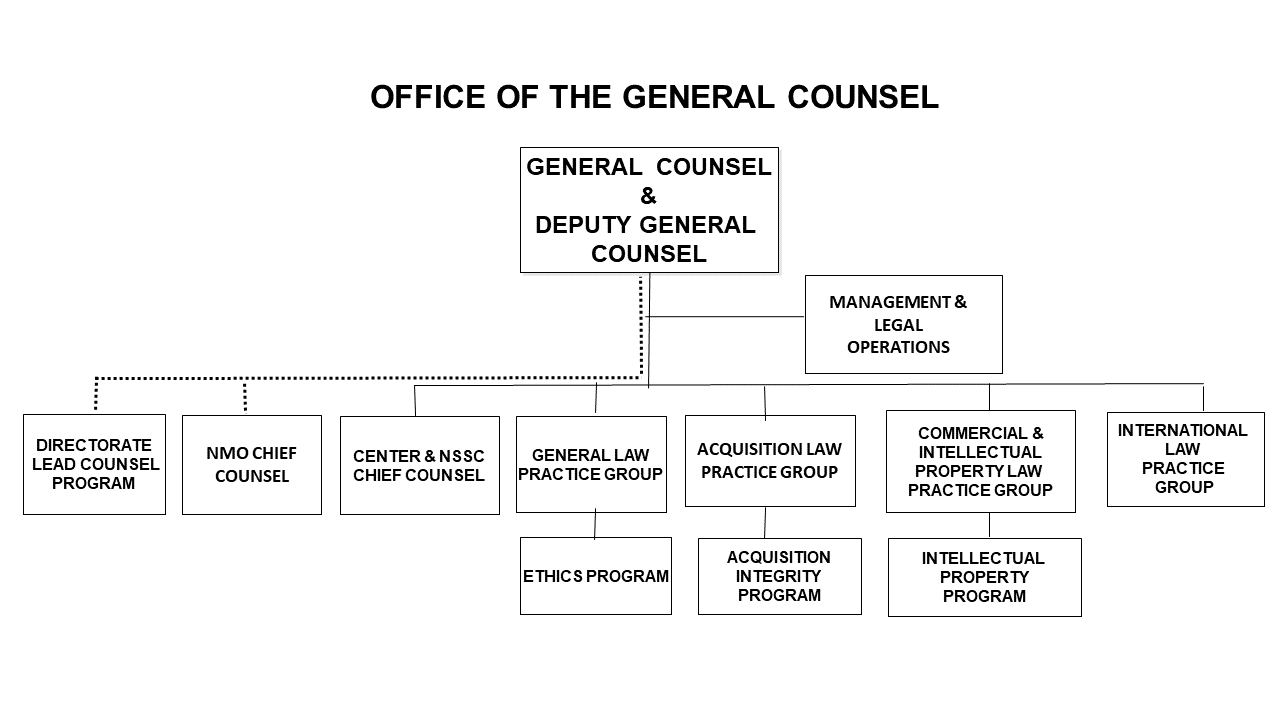
4.18.1 MISSION. The Office of International and Interagency Relations (OIIR) provides executive leadership and coordination for all NASA international activities and partnerships and for policy interactions between NASA and other U.S. Executive Branch offices and agencies. OIIR serves as the principal Agency liaison with the National Security Council, the Office of Science and Technology Policy, the Department of State, and the Department of Defense. OIIR also directs NASA's international relations; negotiates cooperative and reimbursable agreements with foreign space partners; provides management oversight and staff support to NASA's advisory committees, commissions, and panels; and manages the NASA Export Control Program and policy regarding foreign travel by NASA employees.
4.18.2 OVERALL RESPONSIBILITIES. The Associate Administrator (AA) for International and Interagency Relations reports to the NASA Deputy Administrator.
4.18.2.1 Specifically, the AA for International and Interagency Relations:
a. Develops and implements plans that address the organization's goals, objectives, metrics, and actions needed to execute the strategic goals and outcomes in the NASA Strategic Plan.
b. Manages the office functions in order to reduce institutional risk to missions.
c. Directs NASA's international relations through the development, coordination, and implementation of Agency international policies and the development, coordination, and negotiations of NASA international agreements.
d. Serves as the principal advisor to the Office of the Administrator and provides consultation to NASA officials on matters involving international and interagency relations.
e. Disseminates information on foreign aerospace-related developments of programmatic interest to other NASA offices.
f. Serves as the coordinator of Agency-level interaction with U.S. Executive Branch offices and agencies, ensuring that the implementation of Agency programs is consistent with the U.S. Government's domestic and foreign policies, and facilitates NASA participation in selected interagency forums.
g. Serves as the focal point for Agency-wide Export Control Program and J-1 Visitor program and oversees NASA's foreign travel policy.
h. Serves as the Agency focal point for Federal advisory committees and Federal Government-wide commissions and advisory activities, ensuring compliance and managing operations.
i. Ensures statutory, regulatory, and fiduciary compliance.
j. Monitors program performance, as well as effectiveness and efficiency of programs and processes.
k. Provides liaison to external organizations that perform similar functions and establish Government-wide policies and requirements.
l. Oversees reporting as required by Congress, OMB, and other external bodies.
4.18.3 SPECIAL RELATIONSHIPS.
4.18.3.1 The AA for International and Interagency Relations serves as a member of NASA's governance bodies as defined in Chapter 3 of this NPD.
4.18.3.2 The AA for International and Interagency Relations assigns international program specialists to selected Mission Directorates that are aligned to focus on specific countries. These International Program Specialists work with the assigned Associate Administrators and their staffs, providing international relations support. The International Program Specialists report to the relevant International and Interagency Relations Division Director and have access to the AA and Deputy AA for International and Interagency Relations.
4.18.4 IMMEDIATE LINE OF SUCCESSION. In the following order: Deputy Associate Administrator; Director, Export Control and Interagency Liaison Division; and Director, Science Division.
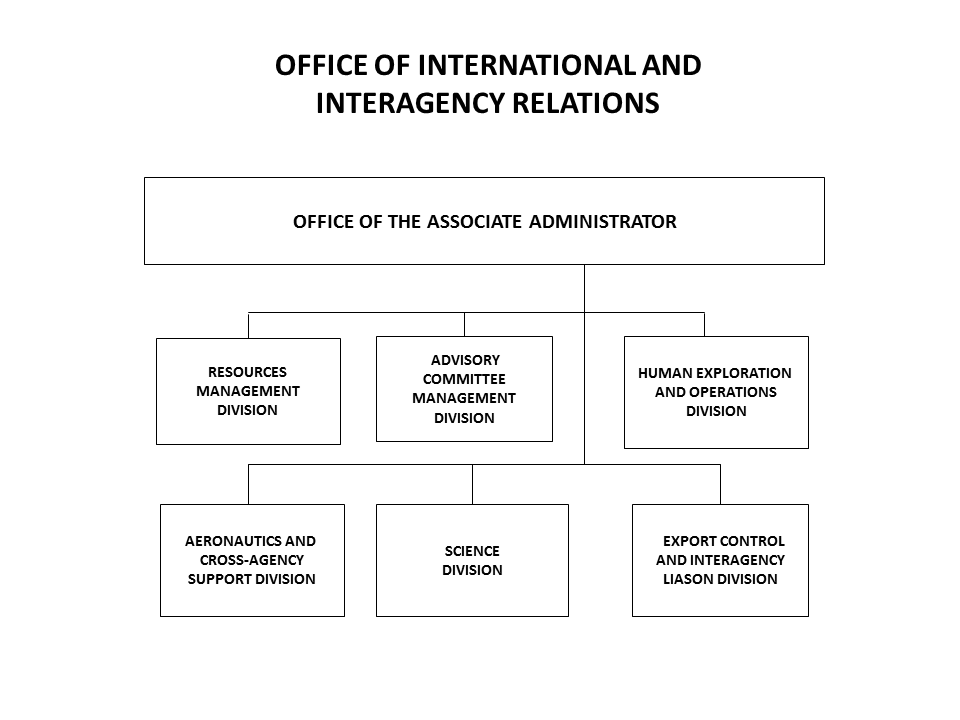
4.19.1 MISSION. The office provides executive leadership, direction, and coordination of all communications and relationships related to legislative issues between NASA and the U.S. Congress, state and local elected officials and governments, and space-related associations and citizen's groups.
4.19.2 OVERALL RESPONSIBILITIES. The Associate Administrator (AA) for Legislative and Intergovernmental Affairs reports to the NASA Administrator.
4.19.2.1 Specifically, the AA for Legislative and Intergovernmental Affairs:
a. Develops and implements plans that address the organization's goals, objectives, metrics, and actions needed to execute the strategic goals and outcomes in the NASA Strategic Plan.
b. Serves as the principal advisor to the Office of the Administrator and provides consultation to NASA officials Agency wide concerning all matters involving relations with the U.S. Congress and state and local elected officials and governments.
c. Defines program objectives and top-level requirements. Develops and oversees Agency-wide policies, strategies, programs, and processes.
d. Establishes and maintains liaison with Members of Congress, their staff, and support organizations; the Executive Office of the President and other departments and agencies; and state and local elected officials and government offices on legislative matters.
e. Arranges for representation by NASA at Congressional hearings, investigations, and other legislative meetings affecting NASA; briefs officials representing NASA on the legislative aspects of their appearances; and reviews statements and other materials to be presented to ensure that they reflect the Administration's and NASA's management policies and objectives.
f. Assists Members of Congress and their staffs in securing appropriate information or assistance. Receives, acknowledges, and replies to Congressional inquiries and requests, coordinating such replies within NASA and with other agencies, as appropriate.
g. Serves as the primary point of contact for state and local elected officials and governments, their staff, and support organizations in their need for NASA representation at state and local government hearings, investigations, and other legislative meetings affecting NASA; briefs officials representing NASA at state and local government events on the legislative aspects of their appearances, and reviews statements and other materials to be presented at state and local government hearings and events to ensure that they reflect the Administration's and NASA's management policies.
h. OLIA, in consultation with the Center Director, will ensure each NASA Center has at least one Center Legislative Officer. The Legislative Officer will serve as the primary point of contract for Federal, state, and local government elected officials and their staff and support organizations for all activity at that Center. These activities include but are not limited to government hearings, investigations, inquiries, tours, and requests for information. The Center Legislative Officers will review statements and other materials to be presented at local, state, and Federal events to ensure they reflect the Administration and NASA's management policies and objectives. No communication with elected officials at any level of government shall be conducted without coordination with the Center Legislative Officer.
i. Establishes and maintains a legislative reference service to meet the needs of all Agency officials.
j. Ensures compliance by NASA with Congressional reporting requirements and coordinates the clearance of legislative matters, proposed outside NASA, with other elements of the Executive Branch.
k. Establishes and maintains liaison with representatives of aeronautics and space-related industry, trade associations, think tanks, nonprofits and NGO government affairs liaisons regarding legislative matters, legislative policy, and legislative activities. Serves as the primary point of contact for the Office of the Administrator for scheduling and orchestrating visits, round-table engagements, and panel discussions involving industry or these entities and the Administrator, Deputy Administrator, and Associate Administrator.
4.19.3 SPECIAL RELATIONSHIPS.
4.19.3.1 The AA for Legislative and Intergovernmental Affairs serves as a member of NASA's governance bodies as defined in Chapter 3 of this NPD.
4.19.3.2 The AA for Legislative and Intergovernmental Affairs assigns Legislative Affairs Specialists to selected Mission Directorate offices. These Legislative Affairs Specialists work with the assigned Associate Administrators and their staffs, providing professional legislative affairs support. The Legislative Affairs Specialists report to the relevant Legislative and Intergovernmental Affairs Division Director who reports to the Deputy AA and AA for Legislative and Intergovernmental Affairs.
4.19.4 IMMEDIATE LINE OF SUCCESSION. In the following order: Deputy AA for Legislative and Intergovernmental Affairs; Director, Legislative Liaison Division; and Principal Legislative Affairs official, Kennedy Space Center Director.
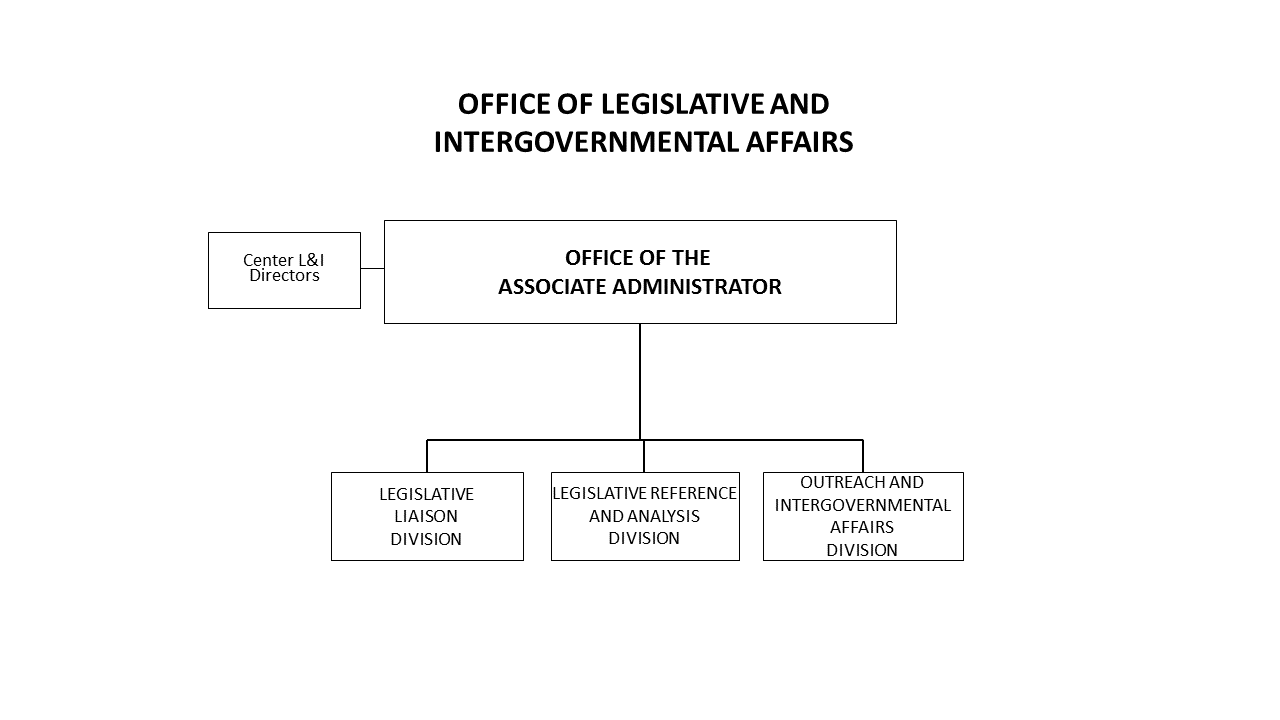
4.20.1 MISSION. The office provides expertise on the utilization of all categories of innovative small business, including minority educational institutions that can deliver technical solutions in support of NASA, and ensures that the Agency is compliant with all Federal laws, regulations, and policies regarding small and disadvantaged business utilization.
4.20.2 OVERALL RESPONSIBILITIES. The Associate Administrator (AA) for Small Business Programs reports to the NASA Deputy Associate Administrator.
a. Serves as the senior NASA advocate responsible for ensuring that the Agency provides the maximum opportunities possible for small businesses, veteran-owned small businesses, service-disabled veteran-owned small businesses, woman-owned small businesses, HUBZone small businesses, small disadvantaged businesses, and minority serving institutions to participate as prime contractors or as subcontractors under NASA contracts.
b. Defines program objectives and top-level requirements.
c. Develops and advises management on policies and procedures for the Agency wide implementation of applicable laws and regulations pertaining to small and disadvantaged business utilization.
d. Negotiates the Agency's annual socioeconomic goals with the NASA Centers and the Small Business Administration (SBA).
e. Appoints, pursuant to Federal law, a technical advisor at each NASA Center to advise SBA Procurement Center Representatives on complex procurements.
f. Conducts nationwide outreach to businesses, both small and large, by hosting and supporting conferences, conducting and overseeing training programs, and giving presentations and speeches to corporate industry groups, other Government agencies, and small business associations.
g. Provides policy guidance to the Agency's small business personnel, activities, and operations. Conducts periodic telecons and meetings to achieve consistency of approach to improve functional performance across the Agency.
h. Assists small businesses in payment issues with the Agency and, where mandated by law, payment issues with major prime contractors.
i. Acts as first-line mediator in small business/Agency disputes.
j. Monitors program performance, as well as effectiveness and efficiency of programs and processes.
k. Manages the preparation, presentation, execution of the Agency's Small Business Programs budget, in alignment with the Agency's near-term and long-term strategies, in collaboration with Agency stakeholders.
4.20.3 SPECIAL RELATIONSHIPS.
4.20.3.1 Serves as a member of NASA's governance bodies as defined in Chapter 3 of this NPD.
4.20.3.2 Serves as a subject-matter expert on all major NASA contracts.
4.20.3.3 Serves on Government-wide boards and task forces that set and revise Federal policy on small and disadvantaged business utilization.
4.20.4 IMMEDIATE LINE OF SUCCESSION. An Acting Associate Administrator for the Office of Small Business Programs will be named by the Deputy Administrator, if and when necessary.
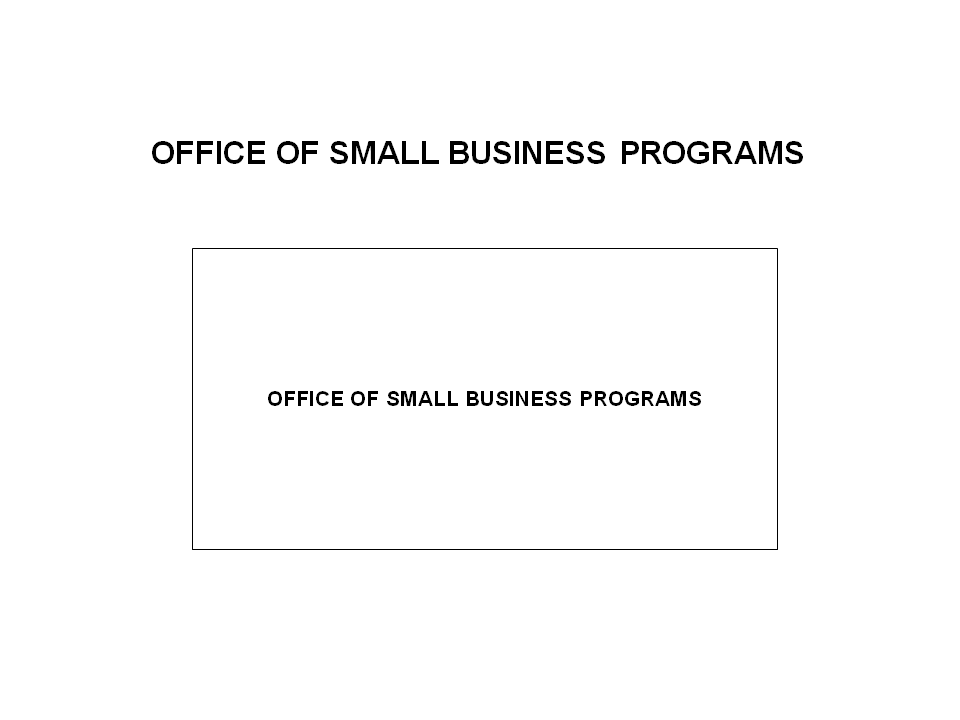
4.21.1 OFFICE MISSION. The Office of the Inspector General (OIG) is an independent and objective unit created by Public Law 95-452, the Inspector General Act. The OIG conducts independent and objective audits and investigations and other evaluations of Agency programs and operations; promotes economy, effectiveness, and efficiency within the Agency; prevents and detects crimes, fraud, waste, and abuse; reviews and makes recommendations regarding existing and proposed legislation and regulations; and keeps the NASA Administrator and Congress fully and currently informed of problems in Agency programs and operations.
4.21.2 OVERALL RESPONSIBILITIES. The Inspector General (IG):
a. Conducts and supervises audits and investigations relating to NASA's programs and operations.
b. Provides leadership and coordination and recommends policies for activities designed (1) to promote economy, efficiency, and effectiveness in the administration of, and (2) to prevent and detect fraud and abuse in, NASA's programs and operations.
c. Provides a means for keeping the Administrator and the Congress fully and currently informed about problems and deficiencies relating to the administration of NASA's programs and operations and the necessity for and progress of corrective action.
d. Reviews existing and proposed legislation and regulations relating to NASA's programs and operations.
e. Audits, or selects an independent external auditor to audit, the Agency's financial statements in accordance with generally accepted Government auditing standards.
f. Reports expeditiously to the Attorney General whenever the IG has reasonable grounds to believe that there has been a violation of Federal criminal law.
g. Prepares semiannual reports summarizing the activities of the office.
h. Reports immediately to the Administrator whenever the IG becomes aware of particularly serious and flagrant problems, abuses, or deficiencies relating to the administration of NASA's programs and operations.
i. Develops and executes the IG budget and controls and expends funds in a separate appropriation account for the OIG.
j. Issues subpoenas for production of all information and documentary and other evidence necessary.
k. Administers or takes from any person an oath, affirmation, or affidavit, whenever necessary.
l. Directly and promptly accesses the NASA Administrator.
m. Selects, appoints, and employs such officers and employees as may be necessary for carrying out the functions, powers, and duties of the office.
4.21.3. SPECIAL RELATIONSHIPS.
4.21.3.1 The IG is appointed by the President, by and with the advice and consent of the U.S. Senate.
4.21.3.2 The IG reports to and is under the general supervision of the Administrator or, to the extent such authority is delegated, the officer next in rank below the Administrator, but shall not report to, or be subject to supervision by, any other officer of NASA. Neither the Administrator nor the officer next in rank below shall prevent or prohibit the IG from initiating, carrying out, or completing any audit, investigation, or review, or from issuing any subpoena during the course of any audit or investigation.
4.21.3.3 The IG may be removed from office by the President. If the IG is removed from office or is transferred to another position or location within NASA, the President shall communicate in writing the reasons for any such removal or transfer to both Houses of Congress, not later than 30 days before the removal or transfer.
4.21.3.4 The IG serves as a member of the President's Council on Integrity and Efficiency, established under Section 1 of Executive Order 12805, dated May 1, 1992.
4.21.3.5 The IG serves as a member of a Data Integrity Board established to oversee agency matching programs in accordance with the Privacy Act, 5 U.S.C. § 552a.
4.21.4 IMMEDIATE LINE OF SUCCESSION. In the following order: Deputy Inspector General; Assistant Inspector General for Investigations; and Assistant Inspector General for Auditing. The process for designating an Acting Inspector General is set forth at 5 U.S.C. § 3345 et. seq.
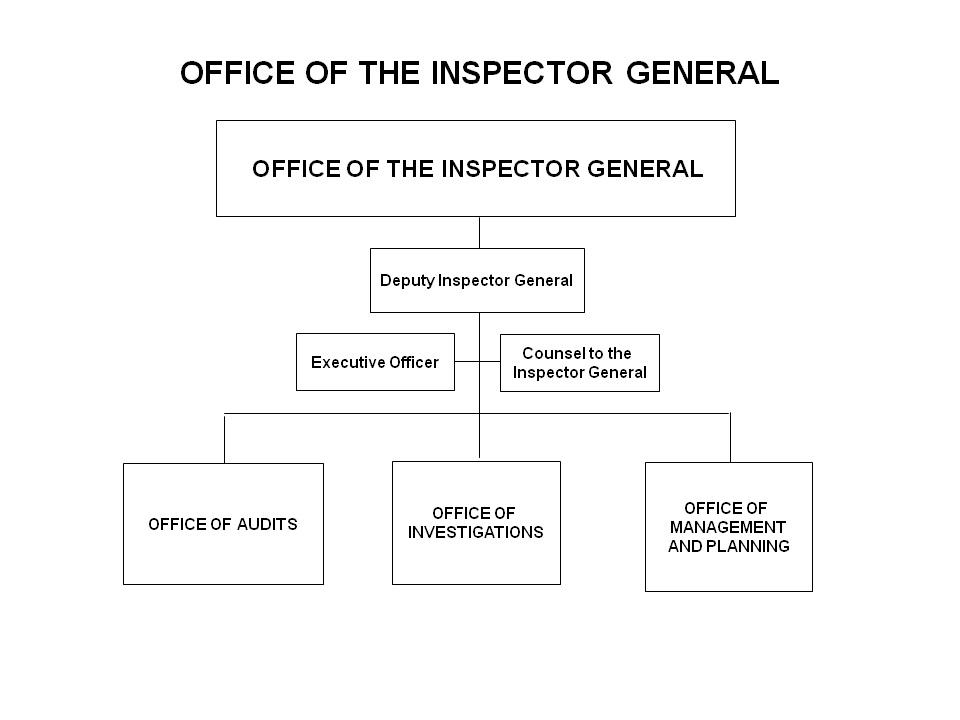
| TOC | ChangeLog | Preface | Chapter1 | Chapter2 | Chapter3 | Chapter4 | Chapter5 | Chapter6 | Chapter7 | ALL | |
| | NODIS Library | Organization and Administration(1000s) | Search | |
This document does not bind the public, except as authorized by law or as incorporated into a contract. This document is uncontrolled when printed. Check the NASA Online Directives Information System (NODIS) Library to verify that this is the correct version before use: https://nodis3.gsfc.nasa.gov.